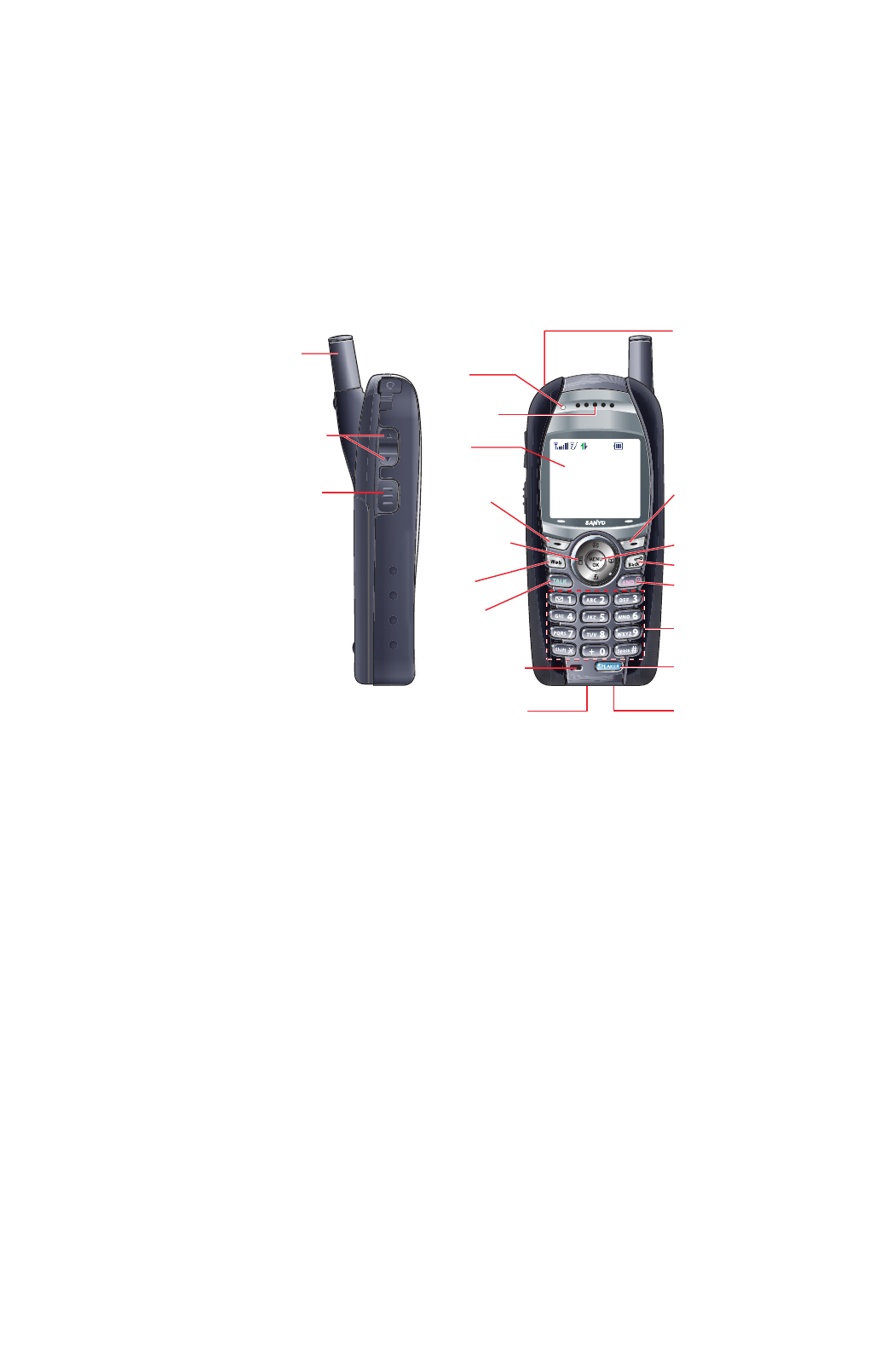Sanyo Electric Co SCP-4930 Tri-Mode Dual-Band Analog/ PCS Phone (AMPS/ CDMA) User Manual RL 4930 FCC GB
Sanyo Electric Co Ltd Tri-Mode Dual-Band Analog/ PCS Phone (AMPS/ CDMA) RL 4930 FCC GB
Users Manual

SCP-4930
Operating Guide
(Draft)
Dual-Band/Tri-Mode

Table of Contents
Getting to Know Your Phone...............................................................................6
Front View of Your Phone..............................................................................................6
Key Features......................................................................................................................7
Viewing the Display Screen...........................................................................................8
Turning Your Phone On and Off................................................................................10
Unlocking the Phone.....................................................................................................10
Using Your Phone’s Battery and Charger ...............................................................11
Displaying Your Phone Number.................................................................................12
Making and Answering Calls............................................................................13
Making Calls....................................................................................................................13
Answering Calls..............................................................................................................13
Changing the Ringer Volume......................................................................................15
Adjusting Volume During a Conversation ..............................................................15
Missed Call Notification...............................................................................................15
Calling Emergency Numbers......................................................................................15
Dialing Options...............................................................................................................16
In-Call Options................................................................................................................17
End-of-Call Options.......................................................................................................17
Saving a Phone Number...............................................................................................18
Finding a Phone Number.............................................................................................18
Dialing and Saving Phone Numbers With Pauses...............................................18
Using Abbreviated Dialing ..........................................................................................19
Dialing From the Contacts Directory.......................................................................19
Using Speed Dialing......................................................................................................20
Controlling Your Phone’s Settings..................................................................21
Sound Settings................................................................................................................21
Ringer Types....................................................................................................................21
Setting Tone Length......................................................................................................22
Setting a Start-up/Power-off Tone.............................................................................22
Using Voice Prompt .......................................................................................................23
Adjusting the Phone’s Volume Settings...................................................................23
Alert Notification............................................................................................................24
1

Silence All.........................................................................................................................24
Display Settings..............................................................................................................25
Changing the Text Greeting........................................................................................25
Changing the Backlight Time Length......................................................................25
Changing the Display Screen Animation................................................................26
Changing the Display for Incoming Calls...............................................................26
Changing the Display for Standby Mode................................................................26
Changing the Screen Saver.........................................................................................27
Changing the Font Size................................................................................................27
Sleep Mode.......................................................................................................................28
Location Settings............................................................................................................28
Airplane Mode.................................................................................................................28
TTY Use With PCS Service.........................................................................................29
Phone Setup Options.....................................................................................................29
Shortcut.............................................................................................................................29
Auto Answer Mode.........................................................................................................30
Display Language...........................................................................................................30
Setting Any Key Answer ..............................................................................................30
Setting Key Guard.........................................................................................................31
Setting Abbreviated Dialing........................................................................................31
Using a Stereo Headset................................................................................................32
Setting the Current Time ............................................................................................32
Setting Your Phone’s Security...........................................................................33
Accessing the Security Menu......................................................................................33
Locking Your Phone.......................................................................................................33
Unlocking Your Phone...................................................................................................34
Changing the Lock Code..............................................................................................34
Calling in Lock Mode ....................................................................................................34
Restricting Calls.............................................................................................................34
Using Special Numbers................................................................................................35
Erasing Contacts Directry...........................................................................................35
Erasing All Downloads..................................................................................................35
Resetting Your Phone....................................................................................................35
Resetting and Locking Your Phone Through SMS...............................................36
Controlling Your Roaming Experience.........................................................37
2

Understanding Roaming..............................................................................................37
Setting Your Phone’s Roam Mode..............................................................................38
Controlling Roaming Charges Using Call Guard.................................................39
Navigating Through Menus...............................................................................41
Menu Navigation............................................................................................................41
Menu Structure...............................................................................................................41
Managing Call History..........................................................................................42
Viewing History ..............................................................................................................42
Call History Options......................................................................................................42
Making a Call From Call History..............................................................................43
Saving a Phone Number From Call History..........................................................43
Prepending a Phone Number From Call History .................................................44
Erasing Call History......................................................................................................44
Using the Contacts Directory............................................................................45
Displaying the Contacts List ......................................................................................45
Contacts List Entry Options.......................................................................................45
Selecting a Character Input Mode............................................................................46
Entering Characters Using T9 Text Input..............................................................46
Entering Characters by Tapping the Keypad........................................................48
Entering Symbols, Numbers, Preset Suffixes, Smileys, and Emoticons........49
Adding a New Contacts Entry....................................................................................49
Finding Contacts List Entries....................................................................................50
Adding a Phone Number to a Contacts Entry.......................................................51
Editing a Contacts Entry.............................................................................................51
Erasing a Contact Entry From the List ..................................................................51
Selecting a Ringer or an Image for an Entry.........................................................51
Secret Contacts Entries................................................................................................52
Dialing PCS Services.....................................................................................................53
Using the Phone’s Calendar and Tools.........................................................54
Using Your Phone’s Calendar .....................................................................................54
Adding Events to the Calendar..................................................................................54
Event Alerts.....................................................................................................................55
Event Alert Menu...........................................................................................................55
3

Viewing Events ...............................................................................................................55
Adding Call Alarms to the Calendar........................................................................56
Call Alarm Alerts............................................................................................................56
Call Alarm Menu............................................................................................................56
Editing an Event or Call Alarm.................................................................................57
Viewing Future or Past Day’s Scheduled Events..................................................57
Erasing Day’s Events or Call Alarms.......................................................................57
Adding To Do List Items ..............................................................................................58
Viewing the To Do List .................................................................................................58
Editing To Do List Items..............................................................................................58
Adding a To Do List Item to the Calendar..............................................................58
Deleting Items From the To Do List.........................................................................58
Purging All Events, Call Alarms, or To Do List Items........................................59
Displaying Your User Address....................................................................................59
Finding Icon Definitions...............................................................................................59
Displaying the Version Information..........................................................................59
Displaying Advanced Information.............................................................................60
Using Your Phone’s Tools .............................................................................................60
Using the Calculator .....................................................................................................60
Using the World Clock..................................................................................................60
Using Your Phone’s Voice Services.................................................................61
Setting Up Screen Call.................................................................................................61
Activating Screen Call..................................................................................................61
Selecting an Announcement for Screen Call..........................................................61
Recording Your Name for a Pre-Recorded Announcement.................................62
Recording a Customized Announcement.................................................................63
Reviewing an Announcement......................................................................................63
Erasing an Announcement ..........................................................................................63
Using Voicemail.........................................................................................................64
Setting Up Your Voicemail...........................................................................................64
Voicemail Notification...................................................................................................64
New Voicemail Message Alerts...................................................................................64
Retrieving Your Voicemail Messages........................................................................65
Voicemail Options...........................................................................................................66
Clearing the Message Icon ..........................................................................................67
4

Using Caller ID...............................................................................................................67
Responding to Call Waiting.........................................................................................68
Making a Three-Way Call............................................................................................68
Using Call Forwarding.................................................................................................69
Using Text SMS Messaging................................................................................69
Displaying a Text Message..........................................................................................69
Composing Text SMS Messages.................................................................................69
Accessing Text SMS Messages ...................................................................................70
Using Preset (Canned) Messages ..............................................................................70
Safety...............................................................................................................................72
Getting the Most Out of Your Reception .................................................................72
Maintaining Safe Use of and Access to Your Phone.............................................73
Caring for the Battery ..................................................................................................74
Acknowledging Special Precautions and the FCC Notice..................................75
5

Getting to Know Your Phone
Front View of Your Phone
6
1. Antenna
2. Side Volume
Key
4. LED
Indicator
5. Earpiece
6. LCD
(display)
7. Softkey
(left)
8. Navigation
Key
9. Web
10. TALK
11. Microphone
12. Accessories
Connector
20. Headset Jack
18. Menu/OK
19. Softkey
(right)
17. BACK
16. END/POWER
15. Keypad
14. SPEAKER Key
13. Charger Jack
3. Ready Link/
Voice Recorder
Button

Key Features
1. Antenna : Fully extend the antenna for the best reception.
2. Side Volume Key : Lets you adjust the receiver volume during a call or ringer
volume in standby mode.
You can also use it to scroll up or down to navigate through the different menu
options.
3. Ready Link / Voice Recorder Button : Allows you to access the PCS Ready Link
List or Voice Recorder menu.
4. LED Indicator : Shows your phone’s connection status at a glance.
5. Earpiece : Lets you hear the caller and automated prompts.
6. LCD (display) : Displays the phone’s main menu, features, modes, etc.
7. Softkey (left) : Lets you select the menu corresponding to the bottom left line on
the LCD.
8. Navigation Key : Lets you navigate quickly and easily through the menu options.
You can access menu shortcuts by pressing Right: Contacts, Left: My Shortcut,
Up: Messaging, and Down: Downloads.
9. Web : Lets you launch the Web.
10. TALK : Lets you place or answer calls, answer Call Waiting, or use Three-Way
Calling and Voice Dial.
11. Microphone : To speak into or record your voice.
12. Accessories Connector : Connects optional accessories, such as a USB cable.
13. Charger Jack : Connects the travel charger (included).
14. SPEAKER Key : Lets you place or receive calls in speakerphone mode.
15. Keypad : Lets you enter numbers, letters, and characters, and navigate within
menus. Press and hold keys 2-9 for speed dialing.
16. END/POWER : Lets you turn the phone on and off, end a call, or return to
standby mode.
17. Back : Lets you clear characters from the screen or display the previous page.
Press and hold for setting Key Guard in standby mode.
18. MENU/OK : Lets you access the phone's menus and select menu options.
19. Softkey (right) : Lets you select the menu corresponding to the bottom right line
on the LCD.
20. Headset Jack : Lets you insert the plug of a headset (sold separately) for hands-
free phone use.
7

Viewing the Display Screen
Your phone’s display screen provides a wealth of information about your phone’s status
and options.
This list identifies the symbols you’ll see on your phone’s display screen:
¡shows your current signal strength.
The more lines you have, the stronger your signal.
¡means your phone cannot find a signal.
¡indicates the call is on hold.
¡tells you a call is in progress.
¡indicates the PCS Ready Link service is enabled.
¡indicates the PCS Ready Link service is enabled and the speakerphone mode is
set to on.
¡indicates the PCS Ready Link service is disabled.
¡indicates PCS Vision / PCS Ready Link access is dormant.
¡indicates PCS Vision / PCS Ready Link access is active.
¡indicates PCS Vision / PCS Ready Link access is disabled.
¡indicates you are “roaming” off of the Nationwide PCS Network.
¡indicates you have missed voice calls.
¡indicates you have missed Ready Link calls.
¡indicates you have scheduled events or call alarms.
¡indicates you have alarm clock notifications.
¡indicates you have new picture messages, voicemail messages, text messages,
and/or Voice SMS.
¡indicates you have urgent messages.
¡indicates you have received 2 or more different types of notifications.
¡shows the level of your battery charge. The more black you see, the more power
you have left.
¡shows your battery is charging.
¡indicates the vibrate feature is set.
¡indicates volume level 4 or 1 and vibrate feature are set.
¡indicates 1 beep feature is set.
¡indicates the voice call ringer setting is off.
¡indicates all the sound settings are off.
¡indicates the Location Service of your phone is enabled.
¡indicates the Location Service of your phone is disabled.
¡indicates you have new voice memos (Screen Call).
¡indicates the Screen Call Auto setting is on.
¡indicates your phone is in TTY mode.
8

¡indicates Headset mode is set to PCS Ready Link and a headset is connected.
¡indicates Headset mode is set to Voice Calls and a headset is connected.
¡indicates the Alarm Clock setting is on.
¡indicates the speakerphone mode is set to on.
Tip: To view a list of your phone’s icons and descriptions, from the main menu
select Settings > Phone Info > Help.
Note: Display indicators help you manage your roaming charges by letting you
know when you’re off the Nationwide PCS Network and whether you’re operating
in digital or analog mode. (For more information, see Controlling Your Roaming
Experience on page 37.)
9

Turning Your Phone On and Off
Turning Your Phone On
To turn your phone on:
Press and hold Efor approximately 2 seconds.
Once your phone is on, it may display “Looking for Service...,” which indicates that
your phone is searching for a signal. When your phone finds a signal, it automatically
enters standby mode – the phone’s idle state. At this point, you are ready to begin
making and receiving calls.
If your phone is unable to find a signal after 15 minutes of searching, a Power Save
feature is automatically activated. When a signal is found, your phone automatically
returns to standby mode.
In Power Save mode, your phone searches for a signal periodically without your
intervention. You can also initiate a search for PCS Service by pressing any key (when
your phone is turned on).
Turning Your Phone Off
To turn your phone off:
Press and hold Efor two seconds until you see the powering down animation on the
display screen.
Your screen remains blank while your phone is off (unless the battery is charging).
Unlocking Your Phone
To unlock your phone, follow these easy steps:
1. Press and hold Eto turn the phone on.
2. Press Unlock (left softkey).
3. Enter your four-digit lock code. (For security purposes, the code is not visible as
you type.)
Note: To select a softkey, press the softkey button directly below the softkey text
that appears at the bottom left and bottom right of your phone’s display screen.
Softkey actions change according to the screen you’re viewing and will not appear if
there is no corresponding action available.
Tip: The Power Save feature helps to conserve your battery power when you are in
an area where there is no signal.
10

Using Your Phone’s Battery and Charger
Battery Capacity
Your PCS Phone is equipped with a Lithium Ion (LiIon) battery. It allows you to
recharge your battery before it is fully drained. The battery provides up to xx hours of
continuous digital talk time (up to xx hours in analog) or up to xx days of continuous
digital standby time (up to xx days in analog).
When the battery level is only 5 minutes of talk time remain, “LOW BATTERY”
notification appears. When there are approximately two minutes of talk time left, the
phone sounds an audible alert and then powers down.
Installing the Battery
To install the LiIon battery:
1. Place the battery into the space beneath the antenna with the metal contacts at
the bottom, facing downward.
2. Gently press down until it’s in place and the battery release latch snaps.
Removing the Battery
To remove your battery:
1. Make sure the power is off so that you don’t lose any stored numbers or messages.
2. Push the battery release latch up and hold the battery.
3. Pull the battery up and out at a 45-degree angle.
Charging the Battery
Your PCS Phone’s LiIon battery is rechargeable and should be charged as soon as
possible so you can begin using your phone.
Keeping track of your battery’s charge is important. If your battery level becomes too
low, your phone automatically turns off and you will lose all the information you were
currently working on. For a quick check of your phone’s battery level, glance at the
battery charge indicator located in the upper-right corner of your phone’s display
screen. If the battery charge is getting too low, the battery icon appears and the
phone sounds a warning tone.
Always use a approved desktop charger, travel charger, or vehicle power adapter to
charge your battery.
Warning: Using the wrong battery charger could cause damage to your phone and
void the warranty.
Tip: Be sure to watch your phone’s battery level indicator and charge the battery
before it runs out of power.
Note: Long backlight settings, searching for service, vibrate mode, and browser use
affect the battery’s talk and standby times.
11

12
Using the Charger
To use the travel charger provided with your phone:
1. Plug the travel charger into a wall outlet.
2. Plug the other end of the travel charger into the bottom of your phone (with the
battery installed).
¡Charging when your phone is turned on:
The battery icon appears on the display while charging.
The battery icon turns to when charging is complete.
¡Charging when your phone is turned off:
The battery icon appears, and the message “BATTERY CHARGING--Power
Off--” is shown on the display while charging. When the battery is completely
discharged, it may take several minutes until the message is shown on the display.
The battery icon turns to , and the message changes to “CHARGING
COMPLETE--Power Off--” when charging is completed.
It takes approximately xx hours to fully recharge a completely rundown battery. With
the approved LiIon battery, you can recharge the battery before it becomes completely
run down.
Displaying Your Phone Number
Just in case you forget your phone number, your PCS Phone can remind you.
To display your phone number:
1. Press Mto access the main menu.
2. Select Contacts and press M.
3. Select My Phone# and press M.
Tip: You can also display your phone number from the Phone Info menu.
Press M, select Settings, select Phone Info, and select Phone#/User ID.
Note: To access the phone’s main menu, press Mfrom standby mode. Menu items
may be selected by highlighting them with the navigation key and pressing M, or
you can press the number corresponding to the menu item on your keypad.

13
Making and Answering Calls
Making Calls
Placing a call from your PCS Phone is as easy as making a call from any land line
phone. Just enter the number and press Tor S, and you’re on your way to
clear calls.
To place a call using your keypad:
1. Make sure your phone is on.
2. Enter a phone number from standby mode. (If you make a mistake while dialing,
press Bto erase one digit at a time. Press and hold Bto erase the entire
number.)
3. Press Tor S. (To place a call when you are roaming and Call Guard is
enabled, see “Controlling Roaming Charges Using Call Guard” on page 39.)
4. When you’re finished, press Eto end the call.
You can also place calls from your PCS Phone by using PCS Voice CommandSM, Speed
Dialing, your Call History listings, and your Contacts directory.
Answering Calls
To answer an incoming call:
1. Make sure your phone is on. (If your phone is off, incoming calls go to voicemail.)
2. Press Tor Sto answer an incoming call. (Depending on your phone’s
settings, you may also answer incoming calls by pressing any number key. See
“Setting Any Key Answer” on page 30 for more information.)
Your PCS Phone notifies you of incoming calls in the following ways:
¡The phone rings and/or vibrates.
¡The indicator light flashes.
¡The backlight illuminates.
¡The screen displays an incoming call message.
¡If available, the phone number of the caller is displayed.
¡If the phone number is in your Contacts list, the contact’s name is displayed.
The following options are also displayed by pressing Options (right softkey). To select
an option, highlight it and press M.
¡Call Guard to answer the call when you are in roaming mode. (See page 39 for
setting Call Guard.)
Important: To maximize performance when using your PCS Phone, extend the
antenna before a call and do not touch the antenna during a call.
Tip: When making calls off of the Nationwide PCS Network, always dial using 11
digits (1 + area code + phone number).
Tip: To redial the last outgoing call, press Tor Stwice.

14
¡Answer to answer the call.
¡Answer: Speaker to answer the call in speakerphone mode.
¡Answer on Hold to put the call on hold. (See “Setting Answer on Hold” on page
14.)
¡Screen Call to answer the call by using a pre-recorded announcement. (Appears
when you are in a PCS Service area or digital roaming area.)
¡Quiet Ringer to mute the ringer. (Appears when the ringer is set.)
Answering a Roam Call With Call Guard Enabled
Call Guard is an option that helps you manage your roaming charges when making or
receiving calls while outside the Nationwide PCS Network. Please see Controlling
Your Roaming Experience on page 37 for more information about roaming.
To answer a call when you are roaming and Call Guard is enabled:
1. Press Tor S.
2. Press 1to proceed while the pop-up message is displayed.
Setting Answer on Hold
This feature allows you to hold an incoming call when you cannot answer immediately.
To set Answer on Hold:
1. When you receive an incoming call, press Options (right softkey).
2. Highlight Answer on Hold and press M. (The caller hears a message to wait
your answer. will display on the screen while the call is on hold.)
To resume the call:
Press Answer (left softkey) or T.
- or -
Press Options (right softkey), highlight Answer or Answer:Speaker and press M.
Ending a Call
To disconnect a call when you are finished:
Press E.
Tip: Time/Date is displayed when you press Bwhile the phone is in use.
Note: Answer on Hold is not available in analog areas.
Note: When your phone is off, in an active PCS Vision Connection, or on a PCS
Ready Link call, incoming calls go directly to voicemail.
Tip: Your PCS Phone offers additional ways to answer calls. (See page 30 for Auto
Answer and see page 30 for Any Key Answer.)

15
Changing the Ringer Volume
To change the ringer volume, press the Side Volume key when the phone is in standby
mode.
Adjusting Volume During a Conversation
When you need to adjust the receiver volume during a conversation, use the Side
Volume key, or press the navigation key up or down while a call is in progress.
Missed Call Notification
When an incoming call is not answered, the Missed Call log and the icon are
displayed on your screen.
To call the Missed Call entry:
Press Tor S. (or for R-Link, press R-Link (left softkey) or press and hold ".
To clear the Missed Call display:
Press Dismiss (right softkey).
Calling Emergency Numbers
You can place calls to 911 (dial 911 and press T), even if your phone is
locked or your account is restricted. Once you dial the numbers, your phone will enter
Emergency mode.
Press Options (right softkey) to display the options.
To select an option, highlight it and press M.
¡Speaker On to activate speakerphone mode. (If you are in speakerphone mode,
the option will appear as Speaker Off to deactivate.)
¡Unlock Phone to unlock your phone (appears only if the phone is locked).
¡Close Menu to close the pop-up menu (appears only if the phone is unlocked).
Tip: Press My Phone (left softkey) to display your phone number during
Emergency mode.
Tip: If you press Ebefore checking your notification, Events (right softkey)
appears in standby mode. Press Events (right softkey) to display the notification
list. To call the entry, highlight the entry and press Call (left softkey), Tor
S.
Tip: If you have two or more notifications, the event list will appear.
Note: To change the ringer volume from the main menu, see “Adjusting the
Phone’s Volume Settings” on page 23.

16
To exit Emergency mode:
1. Press Eduring a 911 call.
2. Press Options (right softkey) to display the options.
3. Highlight Exit Emergency and press M.
To select Emergency mode options:
1. Press Eduring a 911 call.
2. Press Options (right softkey).
¡Call 911 to call 911.
¡Call 911: Speaker to call 911 in speakerphone mode.
¡Exit Emergency to exit Emergency mode.
3. Highlight an option and press M.
Dialing Options
Dialing options are displayed when you press Options (right softkey) after entering
numbers in the phone’s standby mode.
To select an option, highlight it and press M.
¡Call to dial the phone number.
¡Call:Speaker On to dial the phone number in speakerphone mode.
¡Send Message to send a text or voice message (mobile numbers only).
¡Save Phone# to save the phone number in your Contacts list. (See “Saving a
Phone Number” on page 18.)
¡Find to display Contacts list entries that end with the digits you entered. (See
“Finding a Phone Number” on page 18.)
¡Hard Pause to insert a hard pause. (See “Dialing and Saving Phone Numbers
With Pauses” on page 18.)
¡2-Sec. Pause to insert a 2-second pause. (See “Dialing and Saving Phone
Numbers With Pauses” on page 18.)
¡Hyphen to insert a hyphen. (Hyphens are generally for visual appeal only; they
are not necessary when entering numbers.)
¡Abbrev. Dial to dial the phone number in your Contacts list that ends with the
digits you entered. (See “Using Abbreviated Dialing” on page 19.)
Tip: Press Tor Sto display the Recent Calls list. Highlight a number and
press Tor Sto make a call.
Tip: To speed dial a phone number, press and hold the appropriate speed dial key
(locations 2-9).
T
H
Note: When you are in Emergency mode, you can only exit from the options menu.

17
In-Call Options
During a call, your phone displays menu options when you press Options (right
softkey).
To select an option, highlight it and press M.
¡Flash to answer an incoming Call Waiting call or to connect a third party during
Three-Way Calling.
¡Mute or Unmute to mute or reactivate your phone’s microphone.
¡Speaker On or Speaker Off to activate or deactivate speakerphone mode. You
can adjust the speakerphone volume using the Side Volume key.
¡Three-Way Call to call a third party.
¡Call History o access the Call History menu. (See “Managing Call History” on
page 42.)
¡Contacts to access the Contacts menu. (See “Using the Contacts Directory” on
page 45.)
¡Messaging to access the Messaging menu.
¡Settings to access the Settings menu. (See “Controlling Your Phone’s Settings” on
page 21.)
¡Tools/Extras to access the Tools/Extras menu. (See “Using the Phone’s Calendar
and Tools” on page 54.)
End-of-Call Options
To display the following options, press Options (right softkey) within 10 seconds after
disconnecting a call.
To select an option, highlight it and press M.
¡Call Again to dial the phone number.
¡Call:Speaker On to dial the phone number in speakerphone mode.
¡Save Phone# to save the phone number in your Contacts list.
♦Go to Ph. Book appears when the number is already in your Contacts list.
(See “Saving a Phone Number” on page 18.)
Note: The End-of-Call options are not displayed for calls identified as No ID or
Restricted.
Note: The Flash menu appears only for Call Waiting and Three-Way Calling. The
Mute menu does not appear during a 911 call. The Three-Way Call menu does not
appear in Roaming areas.
Warning! Due to higher volume levels, do not place the phone near your ear
during speakerphone use.

18
Saving a Phone Number
Your PCS Vision Phone can store up to 700 phone numbers in up to 500 Contacts
entries (an entry may contain up to seven numbers). Each entry’s name can contain 16
characters. Your phone automatically sorts the Contacts entries alphabetically. (For
more information, see Using the Contacts Directory on page 45.)
To save a number from standby mode:
1. Enter a phone number.
2. Press Options (right softkey).
3. Highlight Save Phone# and press M.
4. Select a label by highlighting Mobile, Home, Work, Pager, Fax, Other, or No
Label and press M.
5. Enter a name and press M. If you have already stored entries in the Contacts
list, you are prompted to select the following entry modes:
¡New Name to enter a new name.
¡From Ph. Book to select a name from the Contacts entry list.
6. Press Save (left softkey).
Finding a Phone Number
You can search Contact list entries for phone numbers that contain a specific string of
numbers.
To find a phone number:
1. Enter the last four or more digits of the number and press Options (right softkey).
(The more numbers you enter, the more specific the search becomes.)
2. Highlight Find and press M. (The Contacts entry that ends with the digits you
entered appears.)
3. Scroll to your desired entry.
¡Press Mto display the entry details.
¡Press Tor Sto dial.
Dialing and Saving Phone Numbers With Pauses
You can dial or save phone numbers with pauses for use with automated systems,
such as voicemail or credit card billing numbers.
There are two types of pauses available on your phone:
¡Hard Pause sends the next set of numbers when you press T.
¡2-Sec. Pause automatically sends the next set of numbers after two seconds.
To dial or save phone numbers with pauses:
1. Enter the phone number and press Options (right softkey).
2. Highlight either Hard Pause or 2-Sec. Pause and press M. (Hard pauses are
displayed as a “H” and 2-second pauses as a “T”.)
3. Enter additional numbers (for example, a passcode or an extension).
Note: You can have multiple pauses in a phone number and combine 2-second and
hard pauses.

19
4. To dial the number, press Tor S. (When dialing a number with a hard
pause, press Tto send the next set of numbers.)
– or –
To save the number in your Contacts list, press Options (right softkey), highlight
Save Phone#, and press M.
Using Abbreviated Dialing
Abbreviated Dialing is another form of speed dialing. It allows you to dial a number by
entering the last 3-6 digits of any number in your Contacts directory. This feature
becomes available when you enable Abbreviated Dialing and enter the appropriate
digits of a phone number.
To place a call using Abbreviated Dialing:
1. Dial the last 3-6 digits of a contact’s phone number.
2. Press Options (right softkey) to display the dialing options.
3. Highlight Abbrev. Dial and press M, T, or S.
Dialing From the Contacts Directory
To dial directly from a Contacts entry:
1. Press Mto access the main menu.
2. Select Contacts and press M.
3. Select Find/Add Entry and press M.
4. Scroll to the desired entry in the Contacts list and press M.
5. Select the number you want to call.
6. Press Options (right softkey) for the menu options.
7. Highlight Call or Call:Speaker On and press Mto place a call.
Note: The icons next to each entry represent the Contacts labels (for example,
Mobile, Home, Work, etc.). A triangle next to an icon means there is another label
for the entry. Press the navigation key right or left to select the desired label.
Tip: You can also place a call by pressing T, S, or Call (left softkey) during
step 5 above.
Shortcut: Press the navigation key right to list entries.
Note: If there is no matching number, your phone dials the number you set for
abbreviated dial with the last four or five digits you entered. If there are matching
numbers in your Contacts list, the abbreviated dial list will be displayed. To place a
call, select a number and press T.
Tip: You can also place a call by pressing Tor Sduring step 2 above.

20
Using Speed Dialing
With this feature, you can dial your favorite entries using one key press for locations
2-9.
To use speed dial for voice calls:
¡From standby mode, press and hold the appropriate key for approximately two
seconds.
- or -
¡From standby mode, press the appropriate key and press T, Sor press
Options [right softkey] and highlight Call or Call:Speaker On) and press M.
The display confirms that the number has been dialed when it shows “Connecting...”.
To use speed dial for PCS Ready Link calls:
¡From standby mode, press the appropriate key and press ".
The display confirms that the number has been dialed when it shows “R-Link
calling...”.
Note: Speed dialing is not available when you are roaming off the Nationwide PCS
Network; when you are roaming, you must always dial using eleven digits (1 + area
code + number).

21
Controlling Your Phone’s Settings
In This Section
¡Sound Settings
¡Display Settings
¡Location Settings
¡Messaging Settings
¡Airplane Mode
¡TTY Use With PCS Service
¡Phone Setup Options
Using the menu options available on your PCS Phone, you can customize
your phone to sound, look, and operate just the way you want it to. This
section describes how you can change your phone’s settings to best suit your needs.
Take a few moments to review these options and to adjust or add settings that are
right for you.
Sound Settings
Ringer Types
Ringer types help you identify incoming calls and messages. You can assign ringer
types to individual Contacts entries, types of calls, and types of messages.
¡Preprogrammed Ringers include a variety of standard ringer types and familiar
music.
¡Vibrating Ringer alerts you to calls or messages without disturbing others.
¡Downloaded Ringers can be downloaded right to your phone.
Selecting Ringer Types for Voice Calls
Your PCS Phone provides a variety of ringer options that allow you to customize your
ring and volume settings. These options allow you to identify incoming calls by the
ring.
To select a ringer type for voice calls:
1. Press Mto access the main menu.
2. Select Settings and press M.
3. Select Sounds and press M.
4. Select Ringer Type and press M.
5. Select Voice Calls and press M.
6. Select With Caller ID or No Caller ID and press M.
7. Scroll to your desired ringer type and press M.
To select a distinctive ringer for voice calls while roaming:
1. Follow steps 1-5 on page 21.
2. Select Roaming and press M.
3. Select Distinctive and press M.
¡To confirm the ringer, press Play (right softkey).
¡If you want to deactivate this feature, select Normal during step 3 above.
Note: When you are in analog area, the Distinctive ringer will be played even if
your voice call setting of roaming is Normal.

22
Selecting Ringer Types for PCS Ready Link Calls
To select a ringer type for PCS Ready Link calls:
1. Press Mto access the main menu.
2. Select Settings and press M.
3. Select Sounds and press M.
4. Select Ringer Type and press M.
5. Select Ready Link and press M.
6. Select Ready Link Calls, R-Link Missed, or R-Link Floor Tone, and press M.
7. Scroll to your desired ringer type and press M.
Selecting Ringer Types for Voicemail, Messaging, or Calendar/Alarm
To select a ringer type for voicemail,or calendar/alarm:
1. Press Mto access the main menu.
2. Select Settings and press M.
3. Select Sounds and press M.
4. Select Ringer Type and press M.
5. Select Voicemail, or Calendar/Alarm, and press M.
6. Press M, scroll to your desired ringer type, and press M.
To select a ringer type for massaging:
1. Follow steps 1 to 4 above.
2. Select Messaging and press M.
3. Select Text, Picture Mail, or Voice SMS and press M.
4. Scroll to your desired options and press M. (If you choose Tones, Melodies,
Downloads or PC Sync, scroll to your desired ringer type and press M.)
Selecting a Tone Length
Longer tone lengths may be better for tone recognition when dialing voicemail or other
automated systems.
To select a tone length:
1. Press Mto access the main menu.
2. Select Settings and press M.
3. Select Sounds and press M.
4. Select Others and press M.
5. Select Tone Length and press M.
6. Select Short or Long and press M.
Setting a Start-up/Power-off Tone
1. Follow steps 1-4 in “Selecting a Tone Length.”
2. Select Start-up Tone or Power-off Tone and press M.
3. Scroll to your desired tone and press M.
¡To confirm the tone, press Play (right softkey).

23
Using Voice Prompt
This feature allows you to hear voice prompts at Voice Recorder, Screen Call setting,
etc. (default setting is Off).
To enable or disable voice prompt:
1. Press Mto access the main menu.
2. Select Settings and press M.
3. Select Sounds and press M.
4. Select Others and press M.
5. Select Voice Prompt and press M.
6. Select On or Off and press M.
Adjusting the Phone’s Volume Settings
You can adjust your phone’s volume settings to suit your needs and your environment.
To adjust the ringer and key volume:
1. Press Mto access the main menu.
2. Select Settings and press M.
3. Select Sounds and press M.
4. Select Ringer/Key Vol. and press M.
5. Select Ringer Volume, Calendar/Alarm, Start-up/Pw-off, or Key Beep and
press M.
6. Adjust a volume level by pressing the navigation key up or down and press M.
To adjust the earpiece or speaker volume:
1. Press Mto access the main menu.
2. Select Settings and press M.
3. Select Sounds and press M.
4. Select Receiver Vol. and press M.
5. Select either Earpiece or Speaker and press M.
6. Adjust a volume level by pressing the navigation key up or down and press M.
To adjust the application volume:
This setting is available for the volume of PC Sync, Java, downloaded data, and
browser.
1. Follow steps 1-3 above.
2. Select Application Vol. and press M.
3. Press M, select a volume level by pressing the navigation key up or down, and
press M.
Tip: You can adjust the ringer volume in standby mode (or the earpiece volume
during a call) by using the Side Volume key or pressing the Navigation key up or
down.
Tip: When ringer volume is set to “Silence All,” voice prompts cannot be heard.

24
To select the vibrate pattern:
1. Follow steps 1-3 above.
2. Select Vibrate Pattern and press M.
3. Select Voice Calls, Ready Link, Voicemail, Messaging or Calendar/Alarm
and press M.
4. Select your desired vibrate pattern and press M.
Alert Notification
Your PCS Phone can alert you with an audible tone when you change service areas,
once a minute during a voice call, for incoming or missed PCS Ready Link calls, or
when a call has been connected.
To set alerts:
1. Press Mto access the main menu.
2. Select Settings and press M.
3. Select Sounds and press M.
4. Select Alerts and press M.
5. Select your desired option and press M.
¡Service sets an alert to notify you of network services parameter changes.
¡Ready Link sets an alert to notify you of Ready Link Calls. Select Ready Link
Calls for incoming PCS Ready Link calls, R-Link Missed for missed PCS Ready
Link calls, or Headset Alert when you use a headset.
¡Voicemail sets an alert to notify you of voice messages. Select Ringer Length to
set the ringer length of Voicemail notification.
¡Messaging sets an alert to notify you of text messages and picture mail. Select
Ringer Length to set the ringer length of Text, Picture Mail, or Voice SMS.
¡Minute Beep sets a minute reminder that beeps ten seconds before the end of
each minute during a call.
¡Signal Fade sets an alert to notify you when your phone loses a signal during a
call.
Silence All
There may be times when you need to silence your phone entirely. The phone’s Silence
All option allows you to mute all sounds without turning your phone off.
To activate Silence All:
1. Press Mto access the main menu.
2. Select Settings and press M.
3. Select Sounds and press M.
4. Select Ringer/Key Vol. and press M.
5. Select Ringer Volume and press M.
Tip: You can select Once or Repeat Alert if you select Ready Link Calls, R-Link
Missed, Voicemail, or Messaging. Repeat Alert sounds an alert every two minutes
for twenty minutes. For Ready Link Calls, it seconds for 20 seconds continuously.

25
6. Press the navigation key down until Silence All appears on the display and press
M.
To deactivate Silence All:
¡Press the Side Volume key up repeatedly to select a desired volume level.
Display Settings
Changing the Text Greeting
The text greeting can be up to fifteen characters and is displayed on your phone’s
screen in standby mode.
You may choose to display a custom greeting or you may display a default greeting on
the phone’s screen.
To display or change your custom greeting:
1. Press Mto access the main menu.
2. Select Settings and press M.
3. Select Display and press M.
4. Select Greeting and press M.
5. Select Custom and press M.
¡You can customize the greeting by entering a personalized greeting.
6. Press M.
To display the default greeting:
1. Follow steps 1-4 above.
2. Select Default and press M.
Changing the Backlight Time Length
The backlight setting lets you select how long the display screen and keypad are
backlit after any key press is made.
To change the LCD backlight setting:
1. Press Mto access the main menu.
2. Select Settings and press M.
3. Select Display and press M.
4. Select Backlight and press M.
5. Select LCD and press M.
6. Select Always On, Always Off, or your defined time length and press M.
¡Always Off always turns the backlight off.
¡Always On keeps the backlight on indefinitely.
Note: The Always On setting returns to the previous value the next time you turn
on the phone.
Tip: When Ringer Volume is set as Silence All, other items are changed to Off and
cannot be highlighted.

26
To change the Keypad backlight setting:
1. Select Key during step 5 above, and press M.
2. Select Always Off or your defined time length and press M.
Changing the Display Screen Animation
Your new PCS Phone offers options for what you see on the display screen during
various phone functions.
To change the animation display:
1. Press Mto access the main menu.
2. Select Settings and press M.
3. Select Display and press M.
4. Select Animation and press M.
5. Select Standby, Outgoing Calls, or Service Search, and press M.
6. Press M, scroll to your desired option and press M.
¡For Standby, you can also set the animation start time. Select after, highlight your
desired start time, and press M.
¡To deactivate this feature, select Off during step 6 above.
Changing the Display for Incoming Calls
You can set the color or downloaded image to be shown on the Incoming Calls display.
To change the incoming calls display:
1. Press Mto access the main menu.
2. Select Settings and press M.
3. Select Display and press M.
4. Select Incoming Calls and press M.
5. Press M, scroll to your desired option, and press M.
6. Select your desired color or image, and press OK (left softkey).
Changing the Display for Standby Mode
This feature enables you to select a variety of items to display in standby mode.
To set your standby display:
1. Press Mto access the main menu.
2. Select Settings and press M.
3. Select Display and press M.
4. Select Standby Display and press M.
5. Select your desired item and press M.
¡Screen Saver selects the screen saver to display.
¡Calendar displays the Calendar.
¡Digital Clock displays the local time in digital view.
Note: Long backlight settings affect the battery’s talk and standby times.

27
¡World Clock displays the time of the selected city or country along with the local
time. You can scroll the World Clock list by pressing the navigation key right or
left. Press Summer (left softkey) or Standard (right softkey) to change between
Daylight Savings and standard time if applicable. (The “ ” icon indicates Daylight
Savings time.)
¡Default returns the standby display to its default setting.
6. Press Mto save the setting to follow each system prompt or when confirming the
preview display.
Changing the Screen Saver
Your new PCS Phone offers you the option of displaying a screen saver while in
standby mode.
To change the screen saver:
1. Press Mto access the main menu.
2. Select Settings and press M.
3. Select Display and press M.
4. Select Standby Display and press M.
5. Select Screen Saver and press M.
6. Press M, scroll to your desired option and press M.
7. Select your desired screen saver and press OK (left softkey).
8. Press Save (left softkey) to save.
Changing the Font Size
You can change the font size settings for the message and browser.
To change the font size:
1. Press Mto access the main menu.
2. Select Settings and press M.
3. Select Display and press M.
4. Select Font Size and press M.
5. Select either Messaging or Browser and press M.
6. Select your desired font size.
¡Press Preview (right softkey) to display a font size example.
7. Press Mto set the selected font.
Tip: From the font example display, select your desired font size by pressing the
navigation key right or left.
Tip: In an area without service, Screen Saver, Calendar, Digital Clock, or World
Clock cannot be shown on the standby display.
Tip: You can also display the World Clock from Tools/Extras menu. (See “Using the
World Clock” on page 60.)

28
Sleep Mode
This feature helps conserve your battery power by restricting the display.
To set sleep mode:
1. Press Mto access the main menu.
2. Select Settings and press M.
3. Select Display and press M.
4. Select Sleep Mode and press M.
5. Select your desired option and press M.
¡To deactivate this feature, select Off during step 5 above.
Location Settings
Your PCS Vision Phone is equipped with a Location feature for use in connection with
location-based services that may be available in the future.
The Location feature allows the network to detect your position. Turning Location off
will hide your location from everyone except 911.
To turn your phone’s Location feature on or off:
1. Press Mto access the main menu.
2. Select Settings and press M.
3. Select Location and press M. (You will see a message on the display.)
4. Press Mor OK (left softkey) to continue.
¡Press the navigation key down to read the whole message.
5. Select On or Off and press M.
When the Location feature is on, your phone’s standby screen will display the icon.
When Location is turned off, the icon will display.
Airplane Mode
Airplane Mode allows you to use many of your phone’s features, such as Games, Voice
Recorder, etc., when you are in an airplane or in any other area where making or
receiving calls or data is prohibited. When your phone is in Airplane Mode, it cannot
send or receive any calls or access online information.
To turn Airplane Mode on or off:
1. Press Mto access the main menu.
2. Select Settings and press M.
3. Select Others and press M.
4. Select Airplane Mode and press M. (You will see a message on the display.)
5. Press Mor OK (left softkey) to continue.
6. Select On or Off and press M.
While in Airplane Mode, your phone’s standby screen will display “Phone Off.”
Note: Even if the Location feature is enabled, no service may use your location
without your expressed permission.

29
TTY Use With PCS Service
A TTY (also known as a TDD or Text Telephone) is a telecommunication device that
allows people who are deaf, hard of hearing, or who have speech or language
disabilities, to communicate by telephone.
Your phone is compatible with variety of TTY devices. Please check with the
manufacturer of your TTY device to ensure that it supports digital wireless
transmission. Your phone and TTY device will connect via a special cable that plugs
into your phone's headset jack. If this cable is not provided with your TTY device,
contact your TTY device manufacturer to purchase the connector cable.
When establishing your PCS Service, please call Customer Service via the state
Telecommunications Relay Service (TRS) by first dialing 711T. Then
provide the state TRS with this number: 866-727-4889.
To turn TTY Mode on or off:
1. Press Mto access the main menu.
2. Select Settings and press M.
3. Select Others and press M.
4. Select TTY and press M. (You will see a message on the display.)
5. Press or OK (left softkey) to continue.
6. Select Enable or Disable and press M.
Phone Setup Options
Shortcut
Your phone offers you the option of assigning a shortcut key to a favorite or often-used
function. Pressing the navigation key to the left in standby mode will launch your
personally designated shortcut.
To assign your shortcut key:
1. Press the navigation key left.
2. Select an unassigned number and press Add (right softkey).
3. Select your desired menu and press Set (right softkey).
IMPORTANT NOTICE: 911 Emergency Calling
It is recommended that TTY users make emergency calls by other means, including
Telecommunications Relay Services (TRS), analog cellular, and landline
communications. Wireless TTY calls to 911 may be corrupted when received by
public safety answering points (PSAPs) rendering some communications
unintelligible. The problem encountered appears related to TTY equipment or
software used by PSAPs. This matter has been brought to the attention of the FCC,
and the wireless industry and PSAP community are currently working to resolve
this.
Note: When you connect TTY devices, your phone will display the icon in TTY
mode. If TTY mode is enabled, the audio quality of non-TTY devices connected to
the headset jack may be impaired.

30
To edit a shortcut name:
1. Press the navigation key left.
2. Select your desired menu and press Options (right softkey).
3. Highlight Edit Name and press M.
4. Edit the name and press OK (left softkey).
5. Press Save (left softkey) to save the name.
To unassign one shortcut or all shortcuts:
1. Press the navigation key left.
2. Select your desired menu and press Options (right softkey).
3. Highlight Reset or Reset all and press M.
4. Select Yes and press M.
¡To unassign all shortcuts, select Reset All during step 3 above.
Auto Answer Mode
You may set your phone to automatically pick up incoming calls in speakerphone mode
or when connected to an optional hands-free car kit and headset.
To set Auto Answer mode:
1. Press Mto access the main menu.
2. Select Settings and press M.
3. Select Others and press M.
4. Select Auto Answer and press M.
5. Select Car Kit/Headset or Speakerphone and press M.
6. Select 5 Seconds, 15 Seconds, or Off and press M.
Display Language
You can choose to display your PCS Phone’s onscreen menus in English or in Spanish.
To assign a language for the phone’s display:
1. Press Mto access the main menu.
2. Select Settings and press M.
3. Select Others and press M.
4. Select Language and press M.
5. Select English or Español and press M.
Setting Any Key Answer
This feature allows you to answer incoming calls by pressing any key (except E,
B, softkeys and sidekeys).
To turn any key answer on or off:
1. Press Mto access the main menu.
2. Select Settings and press M.
3. Select Others and press M.
4. Select Any Key Answer and press M.
5. Select On or Off and press M.

31
Setting Key Guard
Setting Key Guard helps you avoid accidental key presses without blocking incoming
calls or messages. This feature can only be activated when your phone is in standby
mode.
To activate Key Guard:
Press and hold B.
- or -
1. Press Mto access the main menu.
2. Highlight Key Guard and press M.
To deactivate Key Guard:
Press and hold B.
Setting Abbreviated Dialing
Abbreviated Dialing is another form of speed dialing. It allows you to dial a number by
entering 3-6 digits of any number in your Contacts Directory. If the digits you enter do
not match any stored Contacts entry, your phone will automatically prepend the digits
you specify.
To activate this feature:
1. Press Mto access the main menu.
2. Select Settings and press M.
3. Select Others and press M.
4. Select Abbrev. Dial and press M.
5. Select Ph. Book Match and press M.
6. Select Enable and press M.
To set your prepend number:
1. Follow steps 1-4 above.
2. Select Prepend and press M.
3. Select Enable and press M.
4. Select Prepend# and press M.
5. Enter a five- or six-digit number and press Mor OK (left softkey).
¡To deactivate this feature, highlight Disable during step 3 above.
Note: This setting does not apply to 911 or Directory Assistance.
Tip: To dial the prepend number, see “Using Abbreviated Dialing” on page 19.
Tip: With the Phone Book matching feature, your phone displays the Contact’s
name and phone number if the incoming call or outgoing call is in your Contacts
list.
Tip: When Key Guard is set, only Emergency numbers (911,
#911, *911 or ) may be dialed with using Key
Press Echo.

32
Using a Stereo Headset
Your phone comes with a stereo headset for hands free operation. Set the headset
mode to Voice Call or Ready Link and press the Turbo Button (the operation button)
on the headset to activate useful functions.
To connect the headset:
Simply plug the headset into your phone’s headset jack.
To set headset mode:
1. Press Mto access the main menu.
2. Select Settings and press M.
3. Select Others and press M.
4. Select Headset Mode and press M.
5. Select Turbo Button or Ringer Sound and press M.
6. If you select Turbo Button, select an option from the following and press M.
¡Voice Calls: Press the button twice to redial the last call. Press and hold the
button to activate the Voice Recorder.
¡Ready Link: Press twice to redial the last Ready Link call.
¡Off: Turns this feature off.
If you select Ringer Sound, select an option from the following and press M.
¡Normal: Ringers and all of sounds will be heard as usual even when you use the
headset.
¡Headset Only: Ringers and all of sounds will be heard only from your headset
earpiece.
Setting the Current Time
To set the current time when you are roaming in an area with no digital network:
1. Press Mto access the main menu.
2. Select Settings and press M.
3. Select Others and press M.
4. Select Set Time/Date and press M.
5. Set the current time and date and press M.
Note: This feature is only available when you are in an area with no digital
network available.
Note: When using the headset, DO NOT set the volume too high. Listening at
high volume for an extensive period of time may cause hearing loss.
Note: Use only the supplied stereo headset; Please make sure to insert the headset
plug into the headset jack as far as it goes. Improper connection of the headset
plug can cause abnormal sounds.

33
Setting Your Phone’s Security
In This Section
¡Accessing the Security Menu
¡Using Your Phone’s Lock Features
¡Restricting Calls
¡Using Special Numbers
¡Setting Reject Numbers
¡Erasing the Contacts Directory
¡Erasing All Voice Tags
¡Erasing All Downloads
¡Resetting Your Pictures Account
¡Resetting Your Phone
¡Resetting and Locking Your Phone Through SMS
¡Security Features for PCS VisionSM
By using the security settings on your PCS Phone, you receive peace of mind
without sacrificing flexibility. This section will familiarize you with your phone’s
security settings. With several options available, you can customize your phone to
meet your personal needs.
Accessing the Security Menu
All of your phone’s security settings are available through the Security menu. You
must enter your lock code to view the Security menu.
To access the Security menu:
1. Press Mto access the main menu.
2. Select Settings and press M.
3. Select Security and press M.
4. Enter your four-digit lock code. (The Security menu is displayed.)
Locking Your Phone
When your phone is locked, you can only receive incoming calls or make calls to 911
and special numbers.
To lock your phone:
1. From the Security menu (see “Accessing the Security Menu” on page 33), select
Lock Phone and press M.
2. Select Lock Now or On Power-up and press M.
3. Depending on your preference, highlight either Full Lock or Excp. Incom.Calls
and press M.
Tip: If you can’t recall your lock code, try using the last four digits of either your
Social Security number or PCS Phone number or try 0000.

34
¡Full Lock: No phone calls can be made and only special numbers can be received.
(You can still make a call to Emergency number, and special numbers.)
¡Excp. Incom.Calls: No phone calls can be made, however all incoming calls can
be received. (You can still make a call to Emergency number, and special numbers.)
Unlocking Your Phone
To unlock your phone:
1. From standby mode, press Unlock (left softkey).
2. Enter your 4-digit lock code.
Changing the Lock Code
To change your lock code:
1. From the Security Menu, select Others and press M.
2. Select Change Lock and press M.
3. Enter a new 4-digit lock code (“1234” for example).
4. Reenter the new code.
Calling in Lock Mode
You can place calls to 911, and to your special numbers when in lock mode. (For
information on special numbers, see “Using Special Numbers” on page 35.)
To place an outgoing call in lock mode:
To call an emergency number or special number, enter the phone number and press
T.
Restricting Calls
There may be occasions when you want to limit the numbers your phone can call or
from which it can receive calls. You can use the Restrict Calls setting to do just that.
(The Restrict Calls setting does not apply to 911.)
To restrict calls:
1. From the Security Menu, select Others and press M.
2. Select Limit Use and press M.
3. Select Outgoing Calls or Incoming Calls and press M.
4. Select your desired option and press M.
¡Allow All lets you make or receive all calls.
¡PhoneBook Only lets you make or receive calls to or from Contacts entries,
voicemail, or special numbers only.
Tip: If you want to cancel the “On Power-up” setting before turning the phone off,
select Unlocked during step 2 above.

35
¡Special #s Only lets you make or receive calls to or from three special numbers
only. (See “Using Special Numbers” on page 35.)
Using Special Numbers
Special numbers are important numbers that you have designated as being “always
available.” You can receive calls from special numbers even if your phone is locked.
You can save 3 special numbers in addition to your Contacts entries (the same number
may be in both directories).
To add or replace a special number:
1. From the Security Menu, select Others and press M.
2. Select Special #s and press M.
3. Select an entry number and press M.
4. Enter your desired phone number and press M.
- or -
Press Options (right softkey), select From Ph. Book or Voicemail, and press
M.
Erasing Contacts Directory
You can quickly and easily erase all of the contents of your Contacts Directory.
To erase all the names and phone numbers in your Contacts Directory:
1. From the Security Menu, select Erase Ph. Book and press M.
2. Press OK (left soft key) to continue.
3. If you’re sure you want to erase your Contacts, select Ye s and press M.
Erasing All Downloads
To erase all data downloaded from the Web:
1. From the Security Menu, select Erase Download and press M.
2. Press OK (left soft key) to continue.
3. If you’re sure you want to erase all data downloaded from the Web, select Yes and
press M.
¡If you have assigned downloaded data, the function returns to its default setting.
Resetting Your Phone
Resetting the phone restores all the factory defaults, including the ringer types and
display settings. The Contacts, Call History, Calender, and Messaging are not affected.
To reset your phone:
1. From the Security Menu, select Reset Phone and press M.
2. Press OK (left soft key) to continue.
3. If you’re sure you want to reset your phone, select Ye s and press M.
Note: Restricted incoming calls are forwarded to voicemail.

36
Resetting and Locking Your Phone Through SMS
When your phone is lost or stolen, you can erase your important personal information
(such as Contacts entries, call history, and messages) and lock your phone by sending
a special formatted SMS message to your phone.
Send the following format from your computer:
\\ RESET **<Passcode>** RESET
<Passcode> - your defined passcode.
The default passcode is your phone’s 11 - digit ESN (Electronic Serial Number), which
is written on the package or on the phone itself.
To activate this feature, the following presetting is required:
1. Press Mto access the main menu.
2. Select Settings and press M.
3. Select Security and press M.
4. Enter your lock code.
5. Select Others and press M.
6. Select Found Me and press M.
7. Select Reset/Lock and press M.
8. Select Enable and press M.
To unlock a phone that has been locked through SMS, bring the phone to Customer
center.
Changing the Passcode
To change the passcode for the special formatted SMS messages:
1. Follow steps 1-6 above.
2. Select Chg Passcode and press M.
3. Enter new passcode (11 digits).
4. Reenter the new passcode.

37
Controlling Your Roaming Experience
In This Section
¡Understanding Roaming
¡Setting Your Phone’s Roam Mode
¡Controlling Roaming Charges Using Call Guard
Roaming is the ability to make or receive calls when you’re off the
Nationwide PCS Network. Your new XXX Phone SCP-4930 by Sanyo works
anywhere on the Nationwide PCS Network and allows you to roam on other analog
and 1900 and 800 MHz digital networks where we’ve implemented roaming
agreements with other carriers.
This section explains how roaming works as well as special features that let you
manage your roaming experience.
Understanding Roaming
Recognizing the Roaming Icon on the Display Screen
Your phone’s display screen always lets you know when you’re off the Nationwide PCS
Network. Any time you are roaming, the phone displays the roaming icon ( ). If you
are roaming on a digital system, the roaming icon will display along with the text
Digital Roam, and on an analog system, with the text Analog Roam.
Roaming on Other Digital Networks
When you’re roaming on digital networks, your call quality and security will be
similar to the quality you receive when making calls on the Nationwide PCS Network.
However, you may not be able to access certain features, such as PCS Vision.
Note: If you’re on a call when you leave the Nationwide PCS Network and enter an
area where roaming is available , your call is dropped. If your call is dropped in an
area where you think PCS Service is available, turn your phone off and on again to
reconnect to the Nationwide PCS Network.
Note: PCS Ready Link Service is not available in roaming areas.
Note: Unless your PCS Service Plan includes roaming, you will pay a higher per-
minute rate for roaming calls.
Tip: Remember, when you are using your phone off the Nationwide PCS Network,
always dial numbers using 11 digits (1 + area code + number).

38
Roaming on Analog Networks
When you roam on analog networks, you will experience a similar quality provided by
other analog carriers today. Although some features, such as PCS Vision PCS Ready
Link, and PCS Voice Command, will be unavailable, you can still make and receive
calls and access voicemail. If you are accustomed to PCS Service, you may notice some
of the following differences when using analog service:
¡You are more likely to experience static, cross-talk, fade-out, and dropped calls.
¡Some features which are standard on the enhanced Nationwide PCS Network,
such as call waiting, PCS Vision, PCS Ready Link and direct international dialing,
may not be available.
¡Though callers can leave voicemail messages while you are roaming, you may not
receive notification until you return to the Nationwide PCS Network. (See
“Checking for Voicemail Messages While Roaming” on page 38.)
¡There are security and privacy risks (eavesdropping and cloning) that exist with
conventional analog services today.
¡Your battery’s charge will deplete more quickly and you will need to recharge it
more often when you use your phone for analog roaming.
Checking for Voicemail Messages While Roaming
When you are roaming off the Nationwide PCS Network, you may not receive on-
phone notification of new voicemail messages. Callers can still leave messages, but you
will need to periodically check your voicemail for new messages if you are in a roaming
service area for an extended period of time.
To check your voicemail while roaming:
1. Dial 1+area code+your PCS Phone number.
2. When you hear your voicemail greeting, press *.
3. Enter your pass code at the prompt and follow the voice prompts.
When you return to the Nationwide PCS Network, voicemail notification will resume
as normal.
Setting Your Phone’s Roam Mode
Your PCS Vision Phone allows you to control your roaming capabilities. By using the
Roaming menu option, you can determine which signals your phone accepts.
Note: When using your phone in analog mode, the phone may feel warm. This is
normal for analog operation.
Note: If you’re on a call when you leave the Nationwide PCS Network and enter an
area where roaming is available (whether digital or analog), your call is dropped. If
your call is dropped in an area where you think PCS Service is available, turn your
phone off and on again to reconnect to the Nationwide PCS Network.

39
Set Mode
Choose from three different settings on your dual- band phone to control your roaming
experience.
To set your phone’s roam mode:
1. Press Mto access the main menu.
2. Select Settings and press M.
3. Select Roaming and press M.
4. Select Set Mode and press M.
5. Select an option from the following and press M.
¡PCS Only allows you to access the Nationwide PCS Network only and prevents
roaming on other networks.
¡Automatic seeks PCS Service. When PCS Service is unavailable, the phone
searches for an alternate system.
¡Roaming Only seeks both an analog & digital system.
The previous setting (PCS Only or Automatic) is restored the next time the phone
is turned on.
Controlling Roaming Charges Using Call Guard
Your phone has three ways of alerting you when you are roaming off the Nationwide
PCS Network: the onscreen roaming icon, Call Guard, and Data Roam Guard. Call
Guard and Data Roam Guard make it easy to manage your roaming charges by
requiring an extra step before you can place or answer a roaming call and access to
the data service. (This additional step is not required when you make or receive calls
while on the Nationwide PCS Network.)
To turn Call Guard on or off:
1. Press Mto access the main menu.
2. Select Settings and press M.
3. Select Roaming and press M.
4. Select Call Guard and press M.
5. Select On or Off and press M.
To place roaming calls with Call Guard on:
1. From standby mode, dial 1 + area code + the seven-digit number. (You can also
initiate a call from the Contacts directory, Call History, or Messaging.)
2. Press Tor S(or press Options [right softkey] and highlight Call or
Call:Speaker On and press M).
3. Press 1to proceed while the pop-up message is displayed.
- or -
Press any key to erase the pop-up message, press Options (right softkey), highlight
Roam Call, or Roam:Speaker On, and press M.

40
To answer incoming roaming calls with Call Guard on:
Press Options (right softkey), highlight Answer or Answer:Speaker, and press M.
- or -
1. Press Tor S.
2. Press 1to proceed while the pop-up message is displayed.
Reminder: If the Call Guard feature is set to On, you need to take extra steps to
make and receive roaming calls, even if you have selected the Roaming Only
setting (see the previous page).

41
Navigating Through Menus
In This Section
¡Menu Navigation
¡Menu Structure
¡Viewing the Menus
Every function and feature of your SCP-4930 by Sanyo can be accessed
through an onscreen menu. This section is a road map to using your PCS Vision
Phone. Please take a few moments to learn your way around and you’ll find your
phone easier to use.
Menu Navigation
The navigation key on your PCS Vision Phone allows you to scroll through menus
quickly and easily. The scroll bar at the right of the menu keeps track of your position
in the menu at all times.
To navigate through a menu, simply press the navigation key up or down.
Menu Structure
Selecting Menu Items
As you navigate through the menu, menu options are highlighted. Select any
numbered option by simply pressing the corresponding number on the phone’s keypad.
You may also select any item by highlighting it and pressing M.
For example, if you want to view your last incoming call:
1. Press Mto access the main menu.
2. Select Call History by pressing M. (It may already be highlighted.)
3. Select Incoming Calls by pressing 2or by highlighting it and pressing M.
(If you have received any calls, they are displayed on the screen.)
Backing Up Within a Menu
To go to the previous menu:
Press B.
To return to standby mode:
Press E.
Shortcuts
Use your navigation key to quickly access your phone’s menus.
¡Right to take a shortcut to the Contacts menu.
¡Left to take a shortcut to the My Shortcut menu.
¡Up to take a shortcut to the Messaging menu.
¡Down to take a shortcut to the Downloads menu.

42
Managing Call History
In This Section
¡Viewing History
¡Call History Options
¡Making a Call From Call History
¡Saving a Phone Number From Call History
¡Prepending a Phone Number From Call History
¡Erasing Call History
The Call History keeps track of incoming calls, calls made from your PCS
Vision Phone, and missed calls. This section guides you through accessing and
making the most of your Call History.
Viewing History
You’ll find the Call History feature very helpful. It is a list of the last 20 voice calls
and the last 20 Ready Link calls that you placed, accepted, or missed. Call History
makes redialing a number fast and easy. It is continually updated as new numbers are
added to the beginning of the list and the oldest entries are removed from the bottom
of the list.
Each entry contains the phone number (if it is available) and Contact’s name (if the
phone number is in your Contact’s List). Duplicate calls (same number and type of
call) may only appear once on the list except Missed Calls and Recent Calls' list.
To view a Call History entry:
1. Press Mto access the main menu.
2. Select Call History and press M.
3. Select Outgoing, Incoming, Missed or Recent Calls and press M.
Call History Options
For additional information and options on a particular call, highlight a Call History
entry and press Option (right softkey).
¡Call to dial the phone number.
¡Call:Speaker On to dial the phone number in speakerphone mode.
¡Send Message to send a text or voice message.
Tip: The icons next to the name in the Resent Calls list represent the status of the
call history; for Outgoing call, for Incoming call, and for Missed call.
Tip: You can switch the voice call history to the PCS Ready Link call history by
pressing R-Link (left softkey). To return to the voice call history, press Voice Call
(left softkey). This option is not available when PCS Ready Link mode is set to
Disable, or PCS Ready Link is locked.

43
¡Save Phone# to save the phone number (if applicable).
♦Go to Ph. Book appears when the number is already in your Contacts list.
(See “Saving a Phone Number From Call History” on page 43.)
¡Prepend to add numbers to the beginning of the phone number. (See
“Prepending a Phone Number From Call History” on page 44.)
¡Copy to Personal to copy the phone number to the Ready Link Personal List.
(Only appears when PCS Ready Link mode is set to Enable and the number does
not match any stored entry in your Personal List.)
¡Erase to erase the entry.
Making a Call From Call History
To place a call from Call History:
1. Press Mto access the main menu.
2. Select Call History and press M.
3. Select Outgoing, Incoming, Missed or Recent Calls and press M.
4. Scroll to the entry you want to call.
5. Press Tor S.
- or -
Press Options (right softkey), highlight Call or Call:Speaker On, and press M
or T.
Saving a Phone Number From Call History
Your PCS Vision Phone can store up to 700 phone numbers in up to 500 Contacts
entries (an entry may contain up to seven numbers). Each entry’s name can contain
sixteen characters.
To save a phone number from Call History:
1. Scroll to the call history entry you want to save.
2. Press Options (right softkey) to display the options.
3. Highlight Save Phone# and press M.
4. Select the appropriate label (Mobile, Home, Work, Pager, Fax, Other or No
Label) and press M.
5. Enter a name and press M. If you have already stored entries in the Contacts
list, you are prompted to select the following entry mode:
¡New Name to enter a name directly.
¡From Ph. Book to select a name from the Contacts list.
6. Press Save (left softkey).
Note: You cannot save phone numbers already in your Contacts list or from calls
identified as No ID or Restricted. If the selected entry has already been stored in
the Contacts list, Go to Ph. Book appears during step 3 above.
Note: You cannot make calls from Call History to entries identified as No Caller
ID, Private, Restricted ID or Unavailable ID.

44
Prepending a Phone Number From Call History
If you need to place a call from Call History and you happen to be outside your local
area code, you can add the appropriate prefix by prepending the number.
To prepend a phone number from Call History:
1. Scroll to a Call History entry and press Options (right softkey).
2. Highlight Prepend and press M.
3. Enter the digits you want to add to the number.
4. Press Tor Sto place a call.
- or -
Press Options (right softkey) to select your desired option and press M.
¡Call to dial the phone number.
¡Call:Speaker On to dial the phone number in speakerphone mode.
¡Save Phone# to store the phone number in your Contacts directory.
¡Hard Pause to insert a hard pause.
¡2-Sec. Pause to insert a 2-second pause.
Erasing Call History
To erase individual Call History entries, see “Call History Options” on page 42.
To erase Call History:
1. Press Mto access the main menu.
2. Select Call History and press M.
3. Select Erase History and press M.
4. Select Outgoing, Incoming, Missed, Recent Calls, or All and press M.
5. Select Voice Calls or Ready Link and press M.
¡Voice Calls to erase all call histories (for voice call).
¡Ready Link to erase all call histories for PCS Ready Link.
6. Select Yes and press M.
2
H

45
Using the Contacts Directory
In This Section
¡Displaying the Contacts List
¡Contacts List Entry Options
¡Adding a New Contacts Entry
¡Finding Contacts List Entries
¡Assigning an Image to a Contacts Entry
¡Adding a Phone Number to a Contacts Entry
¡Editing a Contacts Entry
¡Erasing a Contact Entry From the List
¡Selecting a Ringer for an Entry
¡Secret Contacts Entries
¡Dialing PCS Services
Now that you know the basics that make it easier to stay in touch with
people and information, you’re ready to explore your phone’s more advanced
features. This section explains how to use your phone’s Contacts Directory and helps
you make the most of your contacts and time when you are trying to connect with the
important people in your life.
Displaying the Contacts List
To display your Contacts list:
Press the navigation key right.
- or -
1. Press Mto access the main menu.
2. Select Contacts and press M.
3. Select Find/Add Entry and press M.
Contacts List Entry Options
To access options of a certain contact, display the Contacts list, highlight an entry and
press M. Then select a phone number and press Options (right softkey). To select an
option, highlight it and press M.
¡Edit to edit the selected entry.
¡Call to dial the selected number.
¡Call:Speaker On to dial the phone number in speakerphone mode.
¡Send Message to send a text or voice message. (mobile numbers only).
¡Call Alarm to set a call alarm for the entry.
¡Set Speed Dial to assign speed dial numbers to your favorite entries.
¡Prepend to alter a phone number by adding more numbers to the front of its
entry. (See “Prepending a Phone Number From Call History” on page 44.)
¡Copy to Personal to copy the phone number to your Ready Link Personal List.
(Only appears when PCS Ready Link mode is set to Enable and the number does
not match any stored entry in your Personal List.)

46
Selecting a Character Input Mode
Your PCS Phone provides convenient ways to enter words, letters, punctuation, and
numbers whenever you are prompted to enter text (for example, when adding a
Contacts entry or when sending PCS Mail and text messages).
To change the character input mode:
1. When you display a screen where you can enter text, press Mode (right softkey).
2. Select a character input mode:
¡Add Word to store words that you use frequently.
¡Preset Messages to enter preset messages.
¡Recent Messages to enter messages you have used recently.
¡Signature to enter your signature.
¡T9 Word to enter characters using predictive T9 Text Input.
¡Alphabet to enter characters by tapping the keypad.
¡SYMBOL to enter symbols.
¡NUMBER to enter numbers.
¡PRESET SUFFIX to enter a preset suffix.
¡SMILEYS to enter smile pictures.
¡Emoticons to enter an emotion icon.
¡Select Language to select the language (English or Spanish).
¡Erase All to erase all text (if applicable).
¡Paste to paste copied or cut text (if applicable).
¡Select Text to select stored text for copying or cutting.
Entering Characters Using T9 Text Input
T9 Text Input allows you to enter a desired word easier by pressing the corresponding
number key for the letters of the word just once per letter. (To select the T9 Word
mode when entering text, see “Selecting a Character Input Mode” on page 46.)
T9 Text Input analyzes the letters you enter using an intuitive word database and
creates a suitable word.
(The word may change as you enter more letters.)
To enter a word using T9 Text Input:
1. Select the T9 Word character input mode. (See “Selecting a Character Input
Mode” on page 46.)
2. Press the corresponding keys once per letter to enter a word (for example, to enter
the word “Bill,” press 2,4,5,5). (If you make a mistake, press B
to erase a single character. Press and hold Bto delete word by word.)
3. To accept a word and insert a space, press #or M.
Note: When entering text, press the *key to change letter capitalization (Abc
>ABC >abc).
Tip: Preset Messages, Recent Messages, and Emoticons are only available
when composing text messages.

47
Adding a Word to the T9 Database
If a word you want to enter does not display as an option when you are using T9 Text
Input, you can add it to the database.
To add a word to the T9 Text Input database:
1. Select the Add Word mode. (See “Selecting a Character Input Mode” on page 46.)
2. Enter the word using multi-tap (Alphabet) text entry and press Save (left softkey).
- or -
1. Press Mto access the main menu.
2. Select Settings and press M.
3. Select Others and press M.
4. Select Text Entry and press M.
5. Select Add Word and press M.
6. Enter the word using multi-tap (Alphabet) text entry and press Save (left softkey).
To edit or erase the words you have added:
1. Follow steps 1-4 above.
2. Select My Words and press M.
3. Select your desired word and press Options (right softkey).
4. To select an option, highlight it and press M.
¡Edit to edit a word in My Words.
¡Erase to erase a word in My Words.
Customizing the T9 Settings
To customize the T9 Settings:
1. Press Mto access the main menu.
2. Select Settings and press M.
3. Select Others and press M.
4. Select Text Entry and press M.
5. Select T9 Settings and press M.
6. Select your desired option and press M.
¡Predict.Txt Mode to allow T9 text input to recognize words you have added to
the T9 database.
¡Word Choice List to display word choice list.
¡Show aft enter to select digits number (1-3 digits) to display the words choice list.
The word choice list will display based on the number of digits you selected.
¡Show aft wait to select how many seconds the phone should wait to display the
words choice list.
For more information about T9 Text Input, visit the Tegic Web site at www.t9.com.
Tip: Mis available during step 3 above only when the Auto Space setting is on.

48
Entering Characters by Tapping the Keypad
To enter characters by tapping the keypad:
1. Select the Alphabet mode. (See “Selecting a Character Input Mode” on page 46.)
2. Press the corresponding keys repeatedly until the desired letter appears (for
example, to enter the word “Bill,” press 2twice, 4three times, 5three
times, and 5three times again).
(If you make a mistake, press Bto erase a single character. Press and hold Bto
delete word by word.)
By default, the first letter of an entry is capitalized and the following letters are
lowercase. After a character is entered, the cursor automatically advances to the next
space aftertwo seconds or when you enter a character on a different key.
Characters scroll in the following order:
In Spanish mode, characters scroll in the following order:
(See page 30 for changing to Spanish language mode.)
After a character is entered, the cursor automatically advances to the next space after
two seconds or when you enter a character on a different key.
Tip: The beginning of the word after the space is changed to upper/lower case
depending on shift mode. You can change the shift mode by pressing *.
Spanish Sequence
Upper Case
. , @ 1 ¿ ? ¡ ! * # /
A Á B C 2
D E É F 3
G H I Í 4
J K L 5
M N Ñ O Ó 6
P Q R S 7
T U Ú Ü V 8
W X Y Z 9
0
Space
Unshifted One-character- shifted Caps Lock
1
2
3
4
5
6
7
8
9
0
#
*
a á b c 2
d e é f 3
g h i í 4
j k l 5
m n ñ o ó 6
p q r s 7
t u ú ü v 8
w x y z 9
Lower Case
Key
English Sequence
Upper Case
. , @ 1 ? ! * # /
A B C 2
D E F 3
G H I 4
J K L 5
M N O 6
P Q R S 7
T U V 8
W X Y Z 9
0
Space
Unshifted One-character- shifted Caps Lock
1
2
3
4
5
6
7
8
9
0
#
*
a b c 2
d e f 3
g h i 4
j k l 5
m n o 6
p q r s 7
t u v 8
w x y z 9
Lower Case
Key

49
Entering Symbols, Numbers, Preset Suffixes, Smileys, and
Emoticons
To enter symbols:
1. In a text entry field, press Mode (right softkey).
2. Highlight SYMBOL and press M.
3. Highlight the line that includes your desired symbol.
4. Press the corresponding key (1-8) with each symbol.
- or -
Highlight your desired symbol by using the navigation key and press M.
To enter numbers:
1. In a text entry field, press Mode (right softkey).
2. Highlight NUMBER and press M.
3. Press the corresponding number key to enter the number.
To enter preset suffixes:
The Preset Suffix menu is a preprogrammed list of common prefixes, suffixes, and
punctuation strings (for example, “www.”, “.com”, and “//”) designed to make text entry
easier and more efficient.
1. In a text entry field, press Mode (right softkey).
2. Highlight PRESET SUFFIX and press M.
3. Highlight your desired word by using the navigation key and press M.
To enter Smileys:
1. In a text entry field, press Mode (right softkey).
2. Highlight SMILEYS and press M.
3. Highlight the line that includes your desired smiley.
4. Press the corresponding key (1-4) with each smiley.
- or -
Highlight your desired smiley by using the navigation key and press M.
Adding a New Contacts Entry
Your PCS Vision Phone can store up to 700 phone numbers in up to 500 Contacts
entries (an entry may contain up to seven numbers). Each entry’s name can contain
sixteen characters.
To add a new entry:
1. Press the navigation key right to display the Contacts list.
2. Highlight <Add Contact> and press M.
3. Enter a name and press M.
Note: PRESET SUFFIX, SMILEYS and Emoticons are not available when
entering a name (of entry, group, or group member) in Ready Link.
Shortcut: In alphabet mode or T9 Word mode, press and hold the key matching
the number you want to enter.

50
4. Select a label by using your navigation key and press M.
5. Enter the phone number or address and press M.
6. Press Save (left softkey).
Finding Contacts List Entries
There are several ways to display your Contacts entries: by name, by speed dial
number, by PCS Ready Link List, and by voice tags. Follow the steps outlined in the
sections below to display entries from the Contacts list menu.
Finding Names
To find Contacts list entries by name:
1. Press the navigation key right to display the Contacts list.
2. Use your navigation key to scroll through the Contacts list.
- or -
Enter the first letter of the name or part of the name. (The display shows the
entries beginning with the letter entered.)
3. Press Mto display the entry’s details.
4. To make the call, highlight the desired number and press T, S, or Call
(left softkey).
To find PCS Ready Link List entries:
1. Press the navigation key right to display the Contacts list.
2. Press Go to (left softkey). Highlight your desired list and press M.
¡Phone Book to display the Contacts list.
¡Company List to display the Company List.
¡Company Groups to display the Company Group List.
¡Personal List to display the Personal List.
¡Personal Groups to display the Personal Group List.
3. Scroll through the list to select your desired entry.
Finding Speed Dial Numbers
To find phone numbers you have stored in speed dial locations:
1. Press Mto access the main menu.
2. Select Contacts and press M.
3. Select Speed Dial #s and press M.
(The Speed Dial #s list appears.)
Note: The Go to (left softkey) option does not appear when PCS Ready Link mode
is set to Disable, or PCS Ready Link is locked.
Tip: You can also add a new Contacts entry by entering a number from standby
mode. See “Saving a Phone Number” on page 18.

51
Finding Voice Tags
To find Voice Tags in your phone:
1. Press and hold Mto activate the Command menu.
2. You’ll hear a tone after a prompt. Say “Tools.”
3. After the prompt, say “Review Voice Tag.” (The list of Voice tags appears.)
Adding a Phone Number to a Contacts Entry
To add a phone number to an entry:
1. Press the navigation key right to display the Contacts list.
2. Scroll to the entry you wish to add and press M.
3. Select a phone number, press Options (right softkey), highlight Edit, and press
M.
4. Select the label field you want to add and press M.
5. Enter the number and press M.
6. Press Save (left softkey).
Editing a Contacts Entry
To make changes to an entry:
1. Press the navigation key right.
2. Scroll to the entry you wish to edit and press M.
3. Select a phone number, press Options (right softkey), highlight Edit, and press
M.
- or -
Select an email address or Web address and press Edit (right softkey).
4. Select the field you want to edit and press M.
5. Edit the entry by using your keypad and press M.
6. Press Save (left softkey) to save your changes.
Erasing a Contacts Entry From the List
To erase the selected entry:
1. Press the navigation key right.
2. Scroll to the entry you wish to delete by using the navigation key and press
Options (right softkey).
3. Highlight Erase Contact and press M.
4. Select Yes and press M.
Selecting a Ringer or an Image for an Entry
You can assign a ringer or an image type to a Contacts entry so you can identify the
caller by the ringer or image type. (See “Ringer Types” on page 21.)
To select a ringer type for an entry:
1. Press the navigation key right.
2. Select the entry for which you want to set the incoming ringer and press M.
3. Highlight a phone number, press Options (right softkey), highlight Edit, and
press M.

52
- or -
Highlight an email address or Web address and press Edit (right softkey).
4. Scroll to Ringer and press M.
5. Scroll to your desired ringer and press M. (Press Play (right softkey) to listen to
the ringer you selected.)
6. Press Save (left softkey) to save the ringer type.
To select an image type for an entry:
1. Follow steps 1-3 on the previous page.
2. Scroll to Picture ID and press M.
3. Highlight your desired image type and press M.
4. Press Save (left softkey) to save the image type.
¡To see a display preview of an image, press Preview (right softkey) during step 4
above.
Secret Contacts Entries
You can hide an entry’s phone number(s) and require your lock code to edit the entry
by making it secret. The entry name is still displayed, but the entry’s phone numbers
are replaced with “<Secret>”.
To make an entry secret:
1. Press the navigation key right.
2. Scroll to the Contacts entry you want to tag as secret.
3. Press Options (right softkey) to display the menu options.
4. Highlight Set Secret and press M.
5. Enter the 4-digit lock code.
6. Select On and press M.
To make an entry public:
1. Press the navigation key right.
2. Scroll to the Contacts entry you want to tag as public.
3. Press Options (right softkey) to display the menu options.
4. Highlight Set Secret and press M.
5. Enter the 4-digit lock code.
6. Select Off and press M.
Tip: If you can’t recall your lock code, try using the last four digits of either your
Social Security number or your PCS Phone number or try 0000.
Note: If you set an animation ringer (indicated with icon) and an image, your
PCS Phone plays the ringer (audio) of the animation ringer and displays the image
you selected.

53
Dialing PCS Services
Your Contacts list is preprogrammed with contact numbers for various PCS Services.
You must be in digital mode to access PCS Services.
To dial a service:
1. Press Mto access the main menu.
2. Select Contacts and press M.
3. Select Services and press M.
4. Select Cust Service, Dir Assistance, Account Info, or Voice Command and
press M.
5. Press Tor S.
- or -
Press Options (right softkey), highlight Call or Call:Speaker On, and press M.

54
Using the Phone’s Calendar and Tools
In This Section
¡Using Your Phone’s Calendar
¡Displaying Personal Information
¡Using Your Phone’s Tools
Your PCS Vision Phone is equipped with several personal information
management features that help you manage your busy lifestyle. This section
shows you how to use these features to turn your phone into a time management
planner that helps you keep up with your contacts, schedules, and commitments. It
takes productivity to a whole new level.
Using Your Phone’s Calendar
Use the Calendar to remind you of events or important calls you need to make. You
can schedule up to 100 events, 15 Call Alarms, and 20 To-Do List items.
Adding Events to the Calendar
Your Calendar helps organize your time and reminds you of important events (up to
100 events).
To add an event:
1. From the Calendar display, select the day you want to add an event and press
Options (right softkey).
2. Highlight Add Event and press M.
3. Select Schedule and press M.
4. Enter the description using your keypad and press M(or press Mode [right
softkey] to select a description from “From To Do List”).
5. Select the following items and press M.
¡Description to enter a description of your event (up to 14 characters).
¡From to schedule the start time.
¡To to schedule the end time.
¡Location to edit the location of your event (up to 14 characters).
¡Alarm to select your desired ringer.
¡Alarm Time to edit the alarm time (number of hours or minutes before the event
starts). Default alarm time is 10 minutes before.
¡Repeat to set the event’s repeating status. Select Once, Daily, Weekly, Monthly,
or Yearly.
6. Press Save (left softkey) to schedule the event.
Tip: The date you have scheduled events for is indicated by “ ᮣ”.
Note: The “From To Do List ”option will not appear if there are no items stored in
the To Do List. See “Adding To Do List Items” on page 58 for details.

55
Event Alerts
There are several ways your PCS Vision Phone alerts you of scheduled events:
¡By playing the alert tone (depending on the Ringer Type and Ringer/Key Vol.).
¡By blinking the LED.
¡By displaying the event’s description on the LCD.
¡By illuminating the LCD backlight (depending on the backlight setting).
Event Alert Menu
When you have an event alarm scheduled, your phone alerts you and displays the
event summary.
To silence an event alert:
Press any key to silence an event alert. (The alarm will play again after 10 minutes.)
¡Press Dismiss (right softkey) to dismiss the event.
Viewing Events
To view your scheduled events:
1. Press Mto access the main menu.
2. Select Tools/Extras and press M.
3. Select Calendar and press M.
4. Select the date for which you set events and press M. (The selected day’s events
list will display.)
Note: If you press Ebefore checking your event, Events (right softkey) appears
in standby mode. Press Events (right softkey) to display the event and press M
to see the event details.
Tip: Press the navigation key up or down to scroll by week through the Calendar
and the Side Volume key to scroll by month.

56
Adding Call Alarms to the Calendar
You can set call alarms to notify you when you need to place a call. The call alarm will
let you know when and to whom to place a scheduled call. You can set up to 15 call
alarms.
To add a call alarm to the Calendar:
1. From the Calendar display, select the date you want to set a call alarm, press M
and press Options (right softkey).
2. Select Add Event and press M.
3. Select Call Alarm and press M.
4. Enter the phone number directly or press Options (right softkey) for options.
¡From Ph. Book to select the desired number from your Contacts list.
¡Voicemail to select the number for voicemail access.
5. Select the following items and press M.
¡Time/Date to edit the start time and date.
¡Alarm to select the ringer alarm.
¡Repeat to set the Call Alarm’s repeat status. Select Once, Daily, Weekly,
Monthly, or Yearly.
6. Press Save (left softkey).
Call Alarm Alerts
There are several ways your PCS Phone alerts you of a scheduled call alarm:
¡By playing the alert tone (depending on the Ringer Type and Ringer Volume
setting).
¡By blinking the LED.
¡By displaying the call alarm notification on the LCD.
¡By illuminating the LCD backlight (depending on the backlight setting).
Call Alarm Menu
When you have scheduled a call alarm, your phone alerts you and displays the icon
and the name or phone number you wish to call.
To respond to a call alarm:
Press Tor Sto dial the phone number.
Other options available include:
¡Press "to make a PCS Ready Link call (if applicable).
¡Press any key (except "or T) to repeat the alarm in 10 minutes.
¡Press Dismiss (right softkey) to dismiss the call alarm.
Note: If you press Ebefore checking your event, Events (right softkey) appears
in standby mode. Press Events (right softkey) to display the event and press M
to see the call alarm details.
Tip: You can also add a call alarm from the Contacts menu (see “Contacts List
Entry Options” on page 45).

57
– or –
Highlight the unchecked event and press Mto see the call alarm details. Press Done
(left softkey) to erase the unchecked event.
- or -
Press Options (right softkey) for the following options (to select an option, highlight it
and press M).
¡Call to dial the scheduled phone number.
¡Call:Speaker On to dial the scheduled phone number in speakerphone mode.
¡Snooze to repeat the alarm in ten minutes.
¡Save Phone# to save the scheduled phone number in your Contacts list. Go to
PhoneBook appears when the number is already in your Contacts list. (See
“Saving a Phone Number” on page 18.)
Editing an Event or Call Alarm
To edit an event or call alarm:
1. From the Calendar display, select the date for which you set events and press M.
2. Select one of the events or call alarms and press M. (The event or call alarm
details appear.)
3. Select the information you want to edit and press M.
4. Enter or select a new setting and press M.
5. Press Save (left softkey).
Viewing Future or Past Day’s Scheduled Events
To view future or past day’s scheduled events:
1. From the Calendar display, press Options (right softkey).
2. Highlight Go To Date and press M.
3. Enter the date by using numeric keys and the navigation key and press Mor OK
(left softkey).
4. Press Monce again to view the day’s event list.
Erasing Day’s Events or Call Alarms
To erase scheduled day’s events or call alarms:
1. From the Event list display (see above), highlight one of the events or call alarms
and press Options (right softkey).
2. Highlight Erase Event and press M.
3. Select Yes and press M.
Note: If you press Exit (left softkey) during step 2 above, you are prompted to
erase the unchecked event. Select Yes to erase or No to cancel.

58
Adding To Do List Items
Your phone can store and manage up to 20 To Do List items.
To add an item to your To Do List:
1. From the Calendar display, press Options (right softkey).
2. Highlight To Do List and press M.
3. Press Options (right softkey).
4. Highlight Add Item and press M.
5. Enter the description (up to 14 characters) and press M.
6. Select Priority and press Mto edit the To Do’s priority. You can select from
Normal, Urgent, or Done.
7. Press Save (left softkey).
Viewing the To Do List
To view your To Do List:
1. From the Calendar display, press Options (right softkey).
2. Highlight To Do List and press M.
¡To see the details of each To Do List item, select an item and press M.
Editing To Do List Items
To edit a To Do List item:
1. From the To Do List display, highlight the item you want to edit and press M.
2. Edit the description or change the priority and press M.
3. Press Save (left softkey).
Adding a To Do List Item to the Calendar
To add your To Do List item to the Calendar:
1. From the To Do List display (see the previous page), select the item you want to
add to the schedule and press Options (right softkey).
2. Highlight Add To Schedule and press M.
¡Add To Schedule to extract the item from the To Do List and make it a scheduled
event.
3. Enter the description using your keypad and press M.
4. Press Save (left softkey).
Deleting Items From the To Do List
To delete To Do List items:
1. From the To Do List display (see the previous page), highlight the item you want to
erase and press Options (right softkey).
2. Highlight your desired option and press M.
¡Erase Item to erase an item from the To Do List.
¡Erase Selection to erase multiple selected To Do List items at one time. Press
Mto check the box(es) next to the To Do List item(s) you want to delete and press
Erase (left softkey) to erase. To check all boxes, press Options (right softkey),
highlight Check All, and press M.

59
¡Erase All to erase all To Do List items.
3. Select Yes and press M.
Purging All Events, Call Alarms, or To Do List Items
To delete all scheduled events, call alarms, or To Do List items:
1. From the Calendar display, press Options (right softkey).
2. Highlight Erase Memory and press M.
3. Select one item from the options and press M.
¡Erase Old deletes old events, call alarms, and To Do List items that are done.
¡Erase All deletes all events, call alarms, and To Do List items.
4. Select Yes or No and press M.
Displaying Your User Address
To display the phone’s current user address:
1. Press Mto access the main menu.
2. Select Settings and press M.
3. Select Phone Info and press M.
4. Select Phone#/User ID and press M.
¡If you sign out, <PCS Vision Disabled> appears on the display.
Finding Icon Definitions
To view an explanation of icons that appear on the display:
1. Press Mto access the main menu.
2. Select Settings and press M.
3. Select Phone Info and press M.
4. Select Help and press M.
5. Select the item for which you want to see the explanation and press M. (The
icon’s explanation appears.)
Displaying the Version Information
To display the version number of the software, hardware, PRL (Preferred Roaming
List), PRI (Product Release Instructions), etc., installed on your PCS Phone:
1. Press Mto access the main menu.
2. Select Settings and press M.
3. Select Phone Info and press M.
4. Select Version and press M.
Note: If you have saved a To Do List item to the Calendar, deleting it from the To
Do List will not delete it from the Calendar. To remove an item saved to the
Calendar, see “Erasing Day’s Event or Call Alarms”.

60
Displaying Advanced Information
To display advanced information such as technology and frequency:
1. Press Mto access the main menu.
2. Select Settings and press M.
3. Select Phone Info and press M.
4. Select Advanced and press M.
Using Your Phone’s Tools
In addition to helping you be more efficient and organized, your PCS Vision Phone
offers useful and entertaining tools.
Using the Calculator
Your phone comes with a built-in calculator.
To use the calculator:
1. Press Mto access the main menu.
2. Select Tools/Extras and press M.
3. Select Calculator and press M.
4. Enter numbers using your keypad. (Press the left softkey to insert a decimal
point.)
5. Press the appropriate navigation key for an arithmetic option (Up for addition,
Down for subtraction, Left for multiplication, Right for division).
6. Enter numbers and press Mfor the result.
¡To clear the numbers, press CLR (right softkey).
¡To exit the calculator, press B.
Using the World Clock
This feature is available only in digital service areas.
To set the world clock display:
1. Press Mto access the main menu.
2. Select Tools/Extras and press M.
3. Select World Clock and press M.
4. The world clock display appears.
¡Press the navigation key right or left to change countries.
Tip: Press Summer (left softkey) or Standard (right softkey) to select between
daylight savings and standard time (if applicable). The icon is shown in summer
mode.

61
Using Your Phone’s Voice Services
In This Section
¡Using the Voice Recorder
¡Setting Up Screen Call
Your PCS Phone’s Voice Services let you place calls using your voice, store
voice reminders, and record memos right on your phone. This section includes
easy-to-follow instructions on using voice-activated dialing and managing voice
recordings.
Setting Up Screen Call
This feature enables you to screen incoming calls by using a recorded announcement,
either one that is pre-recorded or one that you record.
Activating Screen Call
To start Screen Call when you have incoming calls:
1. When the phone rings or vibrates, press Options (right softkey) to display the
options.
2. Highlight Screen Call and press M.
To set Auto Screen Call:
1. Press Mto access the main menu.
2. Select Tools/Extras and press M.
3. Select Voice Services and press M.
4. Select Screen Call and press M.
5. Select Auto and press M.
6. Select On and press M.
7. Set the answering time by using numeric keys or by pressing the navigation key
up or down.
8. Press Mor OK (left softkey).
(The icon is displayed on the standby display.)
Selecting an Announcement for Screen Call
To select a Screen Call announcement:
1. Press Mto access the main menu.
2. Select Tools/Extras and press M.
3. Select Voice Services and press M.
4. Select Screen Call and press M.
5. Select Announcement and press M.
6. Depending on your preference, highlight Pre-Recorded or Custom and press M.

62
Recording Your Name for a Pre-Recorded Announcement
You can use a pre-recorded announcement with or without your name. If you record
your name, your phone uses your name to announce that you are not available to
answer the call.
To record your name:
1. Press Mto access the main menu.
2. Select Tools/Extras and press M.
3. Select Voice Services and press M.
4. Select Screen Call and press M.
5. Select Announcement and press M.
6. Select Pre-Recorded and press Edit (right softkey).
7. Highlight Record Name and press M.
¡If your name has already been recorded, select Yes to overwrite the existing
recording.
8. Press Mto start the first recording.
9. Press Mto stop recording.
10. After the first recording, press Magain to start the second recording.
11. Press Mto stop recording.
Recording a Customized Announcement
To record an announcement:
1. Follow steps 1-5 on the previous page.
2. Select Custom and press Edit (right softkey).
3. Highlight Record and press M.
¡When an announcement has already been recorded, select Yes to overwrite the
existing recording.
4. Press Mto start the first recording.
5. Press Mto stop recording.
6. After the first recording, press Magain to start the second recording.
7. Press Mto stop recording.
Tip: Recording terminates automatically in 12 seconds.
Tip: Recording terminates automatically in 12 seconds.

63
Reviewing an Announcement
To review an announcement:
1. Press Mto access the main menu.
2. Select Tools/Extras and press M.
3. Select Voice Services and press M.
4. Select Screen Call and press M.
5. Select Announcement and press M.
6. Select Pre-Recorded or Custom and press Edit (right softkey).
7. Highlight Play or Play:Speaker and press M.
Erasing an Announcement
To erase an announcement:
1. Follow steps 1-6 above.
2. Select Erase Name to erase the name for a Pre-Recorded announcement and press
M.
- or -
Select Erase to erase the message for a Custom announcement and press M.
3. Select Yes and press M.

64
Using Voicemail
Setting Up Your Voicemail
All unanswered calls to your PCS Phone are automatically transferred to your
voicemail, even if your phone is in use or turned off. Therefore, you will want to set
up your PCS Voicemail and personal greeting as soon as your phone is activated.
To set up your voicemail:
1. Press and hold 1.
2. Follow the system prompts to:
¡Create your pass code
¡Record your greeting
¡Record your name announcement
¡Choose whether or not to activate One-Touch Message Access (a feature that lets
you access messages simply by pressing and holding 1, bypassing the need for
you to enter your pass code).
Voicemail Notification
There are several ways your PCS Phone alerts you of a new message:
¡By displaying a message on the screen.
¡By sounding the assigned ringer type.
¡By the LED blinking red.
¡By displaying at the top of your screen.
New Voicemail Message Alerts
When you receive a new voice message, your phone alerts you and prompts you to call
your voicemail.
To call your voicemail:
Press T.
To display your Missed Log:
Press Events (right softkey).
Important: When you are roaming off the Nationwide PCS Network, you may not
receive notification of new voicemail messages.
It is recommended that you periodically check your voicemail by dialing 1 + area
code + your PCS Phone number. When your voicemail answers, press (*) and
enter your pass code. You will be charged roaming rates when accessing voicemail
while roaming off the Nationwide PCS Network.
Tip: If you have two or more notifications, the event list will appear.
Note: The voicemail setup process may vary in certain Affiliate areas.

65
Retrieving Your Voicemail Messages
You can review your messages directly from your PCS Vision Phone or from any other
touch-tone phone. To dial from your PCS Vision Phone, you can either speed dial your
voicemail or use the menu keys.
Using One-Touch Message Access
Press and hold 1. (Your phone will dial your voicemail box.)
Using the Menu Keys on Your Phone to Access Your Messages
1. Press Mto access the main menu.
2. Select Messaging and press M.
3. Select Voicemail and press M.
4. Press T(or select Call Voicemail or Call: Speaker On and press M).
Using a Phone Other Than Your PCS Phone to Access Messages
1. Dial your PCS Phone number.
2. When your voicemail answers, press *.
3. Enter your pass code.
Voicemail Button Guide
Here’s a quick guide to your keypad functions while listening to voicemail messages.
For further details and menu options.
123
Date/Time Send Reply Advance
456
Replay Rewind Forward
789
Erase Call Back Save
*0#
Cancel Help Skip
Tip: When you call into voicemail, you first hear the header information (date,
time, and sender information) for the message. To skip directly to the message,
press 4during the header.
Note: You are charged for airtime minutes when you are accessing your voicemail
from your PCS Phone.
Note: Your phone accepts messages even when it is turned off. However, you are
only notified of new messages when your phone is turned on and you are in a PCS
Service Area.

66
Voicemail Options
Your PCS Phone offers several options for organizing and accessing your voicemail.
Using Expert Mode
Using the Expert Mode setting for your personal voicemail box helps you navigate
through the voicemail system more quickly by shortening the voice prompts you hear
at each level.
To turn Expert Mode on or off:
1. Press and hold 1to access your voicemail. (If your voicemail box contains any
new or saved messages, press *to access the main voicemail menu.)
2. Press 3to change your Personal Options, following the system prompts.
3. Press 4for Expert Mode.
4. Press 1to turn Expert Mode on or off.
Setting Up Group Distribution Lists
Create up to 20 separate group lists, each with up to 20 customers.
1. Press and hold 1to access your voicemail. (If your voicemail box contains any
new or saved messages, press *to access the main voicemail menu.)
2. Press 3to change your Personal Options, following the system prompts.
3. Press 2for Administrative Options.
4. Press 5for Group Distribution Lists.
5. Follow the voice prompts to create, edit, rename, or delete group lists.
PCS Callback
Return a call after listening to a message without disconnecting from voicemail.
Press 8after listening to a message. (Once the call is complete, you’re returned to
the voicemail main menu.)
Voicemail-to-Voicemail Message
Record and send a voice message to other PCS Voicemail users.
1. From the main voicemail menu, press 2to send a message.
2. Follow the voice prompts to enter the phone number.
3. Follow the voice prompts to record and send your voice message.
Voicemail-to-Voicemail Message Reply
Reply to a voice message received from any other PCS Voicemail user.
1. After listening to a voice message, press 2.
2. Follow the voice prompts to record and send your reply.
Voicemail-to-Voicemail Message Forwarding
Forward a voice message, except those marked “Private,” to other PCS Voicemail
users.
1. After listening to a message, press 6.
2. Follow the voice prompts to enter the phone number.
3. Follow the voice prompts to record your introduction and forward the voice
message.

67
Voicemail-to-Voicemail Receipt Request
Receive confirmation that your voice message has been listened to when you send,
forward, or reply to other PCS users.
1. After you have recorded a message, press 1to indicate you are satisfied with
the message you recorded.
2. Press 4to mark receipt requested.
3. Press 1to send your voicemail message.
Continue Recording
When leaving a voice message, you can choose to continue recording even after you’ve
stopped.
Before pressing 1to indicate that you are satisfied with the message you recorded,
press 4to continue recording.
Extended Absence Greeting
When your phone is turned off or you are off the Nationwide PCS Network for an
extended period, this greeting can be played instead of your normal personal greeting.
1. From the main voicemail menu, press 3for Personal Options.
2. Press 3for Greetings.
3. Press 3to record an Extended Absence Greeting.
Clearing the Message Icon
Your phone may temporarily continue to display the message icon after you have
checked your voice and text messages.
To clear the icon from the display screen:
1. Press Mto access the main menu.
2. Select Messaging and press M.
3. Select Voicemail and press M.
4. Select Clear Count and press M.
5. Select Yes and press M.
Using Caller ID
Caller ID allows people to identify a caller before answering the phone by displaying
the number of the incoming call. If you do not want your number displayed when you
make a call, just follow these easy steps.
To block your phone number from being displayed for a specific outgoing call:
1. Press *67.
2. Enter the number you want to call.
3. Press T.
To permanently block your number, call Customer Service.

68
Responding to Call Waiting
When you’re on a call, Call Waiting alerts you of incoming calls by sounding one beep.
Your phone’s screen informs you that another call is coming in and displays the caller’s
phone number (This feature may not be available while you are in analog area).
To respond to an incoming call while you’re on a call:
Press T(or press Options [right softkey], highlight Flash, and press M). (This
puts the first caller on hold and answers the second call.)
To switch back to the first caller:
Press Tagain (or press Options [right softkey], highlight Flash, and press M).
To respond to an incoming call when Answer on Hold is activated:
Press T(or press Options [right softkey], highlight Flash, and press M). (The
Answer on Hold will be automatically deactivated. See page 14 for Answer on Hold.)
To switch back to the first caller:
Press Tagain (or press Options [right softkey], highlight Flash and press M).
Making a Three-Way Call
With Three-Way Calling, you can talk to two people at the same time. When using this
feature, the normal airtime rates will be charged for each of the two calls.
To make a Three-Way Call:
1. Enter a number you wish to call and press Tor S.
2. Once you have established the connection, press T(or press Options [right
softkey], highlight Three-Way Call, and press M). (This puts the first caller on
hold.)
3. Dial the second number you wish to call and press T(or press Options [right
softkey], highlight Call or Call:Speaker On, and press M).
4. When you’re connected to the second party, press Tagain (or press Options
[right softkey], highlight Flash, and press M) to begin your three-way call.
If one of the people you called hangs up during your call, you and the remaining caller
stay connected. If you initiated the call and are the first to hang up, all three callers
are disconnected.
Tip: Call Waiting and Three-Way Calling may not be available while roaming off
the Nationwide PCS Network.
Tip: You can also begin a Three-Way Call by displaying a phone number stored in
your Contacts, Call History, or Messaging. To display the options, press Options
(right softkey) during step 3 above.
Tip: For those calls where you don’t want to be interrupted, you can temporarily
disable Call Waiting by pressing *70 before placing your call. Call
Waiting is automatically reactivated once you end the call.

69
Using Call Forwarding
Call Forwarding lets you forward all your incoming calls to another phone number –
even when your phone is turned off. You can continue to make calls from your phone
when Call Forwarding is activated.
To activate Call Forwarding:
1. Press *72.
2. Enter the area code and phone number to which your future calls should be
forwarded.
3. Press T. (You will see a message and hear a tone to confirm the activation of
Call Forwarding.)
To deactivate Call Forwarding:
1. Press *720.
2. Press T. (You will see a message and hear a tone to confirm the deactivation.)
Using Text SMS Messaging
With Text SMS Messaging, you can use a person’s wireless phone number to send
instant text messages from your PCS Phone to their messaging-ready phone – and
they can send messages to you. When you receive a new message, it will automatically
display on your phone’s screen.
In addition, Text SMS Messaging includes a variety of preset messages, such as “Can’t
talk right now. Send me a message.” that make composing messages fast and easy. You
can also customize your own preset messages (up to 50 characters) from your PCS
Phone.
Displaying a Text Message
To display a Text SMS message from the main menu:
1. Press Mto access the main menu.
2. Select Messaging and press M.
3. Select Text and press M.
4. Select Inbox, Sent Mail, Pending, Drafts, or your defined folder and press M.
( indicates an unread message.)
5. Highlight the message you want to display and press M. (To display the message
options, press Options [right softkey].)
Composing Text SMS Messages
To compose a Text SMS message:
1. Press Mto access the main menu.
2. Select Messaging and press M.
3. Select Send Message and press M.
4. Select Text and press M.
5. Select Mobile or Email to enter recipient’s wireless phone number or email
address directly.
Note: You are charged a higher rate for calls you have forwarded.

70
6. Select Phone Book Entry and select the list from following:
¡Phone Book Entry to select a recipient from your Contacts list. (qualifying Phone
Book entries must contain a wireless phone number or an email address).
¡Company List Ent. to select a recipient from your company list.
¡Personal List Ent. to select a recipient from your personal list.
¡Personal Grp. Ent. to select a recipient from your personal group list.
¡From Recent List to select recipients from a list of recent message recipients.
7. Press Mto select the recipient.
8. Press Done (left softkey).
9. Press Next (left softkey) when you are finished selecting and entering recipients.
10. Select Message and compose a message or use the preset messages or smileys
(icons).
¡Press Mode (right softkey) for different character input mode.
11. To set the message priority, scroll to Priority and press M.
12. Select Ordinary or Urgent and press M.
13. Review your message and press Send (left softkey). (You may also select additional
messaging options by pressing Options [right softkey] to set the callback number
or change the recipients, etc.)
Accessing Text SMS Messages
To read a Text SMS message:
¡When you receive a text message, it will automatically appear on your phone’s
main display screen. Press View (left softkey) to read the message. Use your
navigation key to scroll down and view the entire message.
To reply to a Text SMS message:
1. While the message is open, select Reply (left softkey).
2. Select Text and press M.
3. Compose your reply or press Mode (right softkey) to select a character input mode.
4. Review your reply and press Send (left softkey).
Using Preset (Canned) Messages
Preset messages make sending text messages to your friends, family, and co-workers
easier than ever.
To add and/or edit Preset messages:
1. Press Mto access the main menu.
2. Select Settings and press M.
3. Select Messaging and press M.
4. Select Preset Msgs and press M.
5. Highlight a message you wish to edit and press M.
6. Enter your new message or changes and press OK (left softkey).
Tip: To add additional recipients, follow steps 5-8 above. You may add recipients up
to 25 recipients per message.

71
To reset Preset messages:
1. Follow steps 1-4 above.
2. Press Options (right softkey).
3. Highlight Reset All Msgs and press M.
4. Select Yes .

72
Safety
In This Section
¡Getting the Most Out of Your Reception
¡Maintaining Safe Use of and Access to Your Phone
¡Caring for the Battery
¡Acknowledging Special Precautions and the FCC Notice
¡Consumer Information on Wireless Phones
¡Owner’s Record
¡Phone Guide Proprietary Notice
Part of getting the most out of your PCS Phone is learning how the phone
works and how to care for it. This section outlines performance and safety
guidelines that help you understand the basic features of your phone’s operation.
Getting the Most Out of Your Reception
Keeping Tabs on Signal Strength
The quality of each call you make or receive depends on the signal strength in your
area. Your phone informs you of the current signal strength by displaying a number of
bars next to the signal strength icon. The more bars displayed, the stronger the signal.
If you’re inside a building, being near a window may give you better reception.
Understanding the Power Save Feature
If your phone is unable to find a signal after 15 minutes of searching, a Power Save
feature is automatically activated. If your phone is active, it periodically rechecks
service availability; you can also check it yourself by pressing any key. Anytime the
Power Save feature is activated, a message is displayed on the screen. When a signal
is found, your phone returns to standby mode.
Understanding How Your Phone Operates
Your phone is basically a radio transmitter and receiver. When it’s turned on, it
receives and transmits radiofrequency (RF) signals. When you use your phone, the
system handling your call controls the power level. This power can range from 0.006
watts to 0.2 watts in digital mode.
Knowing Radio Frequency Safety
The design of your PCS Phone complies with updated NCRP standards described
below.
In 1991-92, the Institute of Electrical and Electronics Engineers (IEEE) and the
American National Standards Institute (ANSI) joined in updating ANSI’s 1982
standard for safety levels with respect to human exposure to RF signals. More than
120 scientists, engineers and physicians from universities, government health agencies
and industries developed this updated standard after reviewing the available body of
research. In 1993, the Federal Communications Commission (FCC) adopted this
updated standard in a regulation. In August 1996, the FCC adopted hybrid standard
consisting of the existing ANSI/IEEE standard and the guidelines published by the
National Council of Radiation Protection and Measurements (NCRP).

73
Maintaining Your Phone’s Peak Performance
There are several simple guidelines to operating your phone properly and maintaining
safe, satisfactory service.
¡Hold the phone with the antenna raised, fully-extended, and over your shoulder.
¡Try not to hold, bend, or twist the phone’s antenna.
¡Don’t use the phone if the antenna is damaged.
¡Speak directly into the mouthpiece.
¡Avoid exposing your phone and accessories to rain or liquid spills. If your phone
does get wet, immediately turn the power off and remove the battery.
Maintaining Safe Use of and Access to Your Phone
FAILURE TO FOLLOW THE INSTRUCTIONS OUTLINED MAY LEAD TO
SERIOUS PERSONAL INJURY AND POSSIBLE PROPERTY DAMAGE
Using Your Phone While Driving
Talking on your phone while driving (or operating the phone without a hands-free
device) is prohibited in some jurisdictions. Laws vary as to specific restrictions.
Remember that safety always comes first.
Following Safety Guidelines
To operate your phone safely and efficiently, always follow any special regulations in a
given area. Turn your phone off in areas where use is forbidden or when it may cause
interference or danger.
Using Your Phone Near Other Electronic Devices
Most modern electronic equipment is shielded from radiofrequency (RF) signals.
However, RF signals from wireless phones may affect inadequately shielded electronic
equipment.
RF signals may affect improperly installed or inadequately shielded electronic
operating systems and/or entertainment systems in motor vehicles. Check with the
manufacturer or their representative to determine if these systems are adequately
shielded from external RF signals. Also check with the manufacturer regarding any
equipment that has been added to your vehicle.
Consult the manufacturer of any personal medical devices, such as pacemakers and
hearing aids, to determine if they are adequately shielded from external RF signals.
Turning Off Your Phone Before Flying
Turn off your phone before boarding any aircraft. To prevent possible interference with
aircraft systems, the U.S. Federal Aviation Administration (FAA) regulations require
you to have permission from a crew member to use your phone while the plane is on
the ground. To prevent any risk of interference, FCC regulations prohibit using your
Note: Always turn off the phone in health care facilities and request permission
before using the phone near medical equipment.
Note: For the best care of your phone, only authorized personnel should service
your phone and accessories. Faulty service may void the warranty.

74
phone while the plane is in the air.
Turning Off Your Phone in Dangerous Areas
To avoid interfering with blasting operations, turn your phone off when in a blasting
area or in other areas with signs indicating two-way radios should be turned off.
Construction crews often use remote-control RF devices to set off explosives.
Turn your phone off when you're in any area that has a potentially explosive
atmosphere. Although it's rare, your phone and accessories could generate sparks.
Sparks can cause an explosion or fire, resulting in bodily injury or even death. These
areas are often, but not always, clearly marked. They include:
¡Fueling areas such as gas stations.
¡Below deck on boats.
¡Fuel or chemical transfer or storage facilities.
¡Areas where the air contains chemicals or particles such as grain, dust, or metal
powders.
¡Any other area where you would normally be advised to turn off your vehicle’s
engine.
Restricting Children’s Access to Your Phone
Your phone is not a toy. Do not allow children to play with it as they could hurt
themselves and others, damage the phone or make calls that increase your PCS
Invoice.
Caring for the Battery
Protecting Your Battery
The guidelines listed below help you get the most out of your battery’s performance.
¡Use only PCS-approved batteries and desktop chargers. These chargers are
designed to maximize battery life. Using other batteries or chargers voids your
warranty and may cause damage.
¡In order to avoid damage, charge the battery only in temperatures that range from
32°F to 113°F (0°C to 45°C).
¡Don’t use the battery charger in direct sunlight or in high humidity areas, such as
the bathroom.
¡Never dispose of the battery by incineration.
¡Keep the metal contacts on top of the battery clean.
¡Don’t attempt to disassemble or short-circuit the battery.
¡The battery may need recharging if it has not been used for a long period of time.
¡It’s best to replace the battery when it no longer provides acceptable performance.
It can be recharged hundreds of times before it needs replacing.
¡Don’t store the battery in high temperature areas for long periods of time. It’s best
to follow these storage rules:
Less than one month: 4°F to 140°F (–20°C to 60°C)
More than one month: 4°F to 113°F (–20°C to 45°C)
Note: Never transport or store flammable gas, liquid or explosives in the
compartment of your vehicle that contains your phone or accessories.

75
Disposal of Lithium Ion (LiIon) Batteries
For safe disposal options of your LiIon batteries, contact your nearest PCS authorized
service center.
Special Note: Be sure to dispose of your battery properly. In some areas, the disposal
of batteries in household or business trash may be prohibited.
Acknowledging Special Precautions and the FCC Notice
FCC Notice
This phone may cause TV or radio interference if used in close proximity to receiving
equipment. The FCC can require you to stop using the phone if such interference
cannot be eliminated.
Vehicles using liquefied petroleum gas (propane or butane) must comply with the
National Fire Protection Standard (NFPA-58). For a copy of this standard, contact the
National Fire Protections Association, One Batterymarch Park, Quincy, MA 02269,
Attn.: Publication Sales Division.
Cautions
Any changes or modifications to your phone not expressly approved in this document
could void your warranty for this equipment and void your authority to operate this
equipment. Only use approved batteries, antennas and chargers. The use of any
unauthorized accessories may be dangerous and void the phone warranty if said
accessories cause damage or a defect to the phone.
Although your phone is quite sturdy, it is a complex piece of equipment and can be
broken. Avoid dropping, hitting, bending or sitting on it.
Body-Worn Operation
To maintain compliance with FCC RF exposure guidelines, if you wear a handset on
your body, use the supplied or approved carrying case, holster or other body-worn
accessory. If you do not use a body-worn accessory, ensure the antenna is at least 7/16
inch (1.5 centimeters) from your body when transmitting. Use of non-approved
accessories may violate FCC RF exposure guidelines.
For more information about RF exposure, visit the FCC Website at www.fcc.gov.
Specific Absorption Rates (SAR) for Wireless Phones
The SAR is a value that corresponds to the relative amount of RF energy absorbed in
the head of a user of a wireless handset.
The SAR value of a phone is the result of an extensive testing, measuring and
calculation process. It does not represent how much RF the phone emits. All phone
models are tested at their highest value in strict laboratory settings. But when in
operation, the SAR of a phone can be substantially less than the level reported to the
FCC. This is because of a variety of factors including its proximity to a base station
antenna, phone design and other factors. What is important to remember is that each
phone meets strict federal guidelines. Variations in SARs do not represent a variation
in safety.
All phones must meet the federal standard, which incorporates a substantial margin
Note: For safety, do not handle a damaged or leaking LiIon battery.

76
of safety. As stated above, variations in SAR values between different model phones do
not mean variations in safety. SAR values at or below the federal standard of 1.6 W/kg
are considered safe for use by the public.
The highest reported SAR values of the SCP-4930 are:
AMPS mode (Part 22):
Head: 1.01 W/kg; Body-worn: 0.516 W/kg
PCS mode (Part 24):
Head: 0.374 W/kg; Body-worn: 1.15 W/kg
FCC Radiofrequency Emission
This phone meets the FCC Radiofrequency Emission Guidelines.
FCC ID number: AEZSCP-4930. More information
on the phone's SAR can be found from the following FCC Website:
http://www.fcc.gov/oet/fccid.